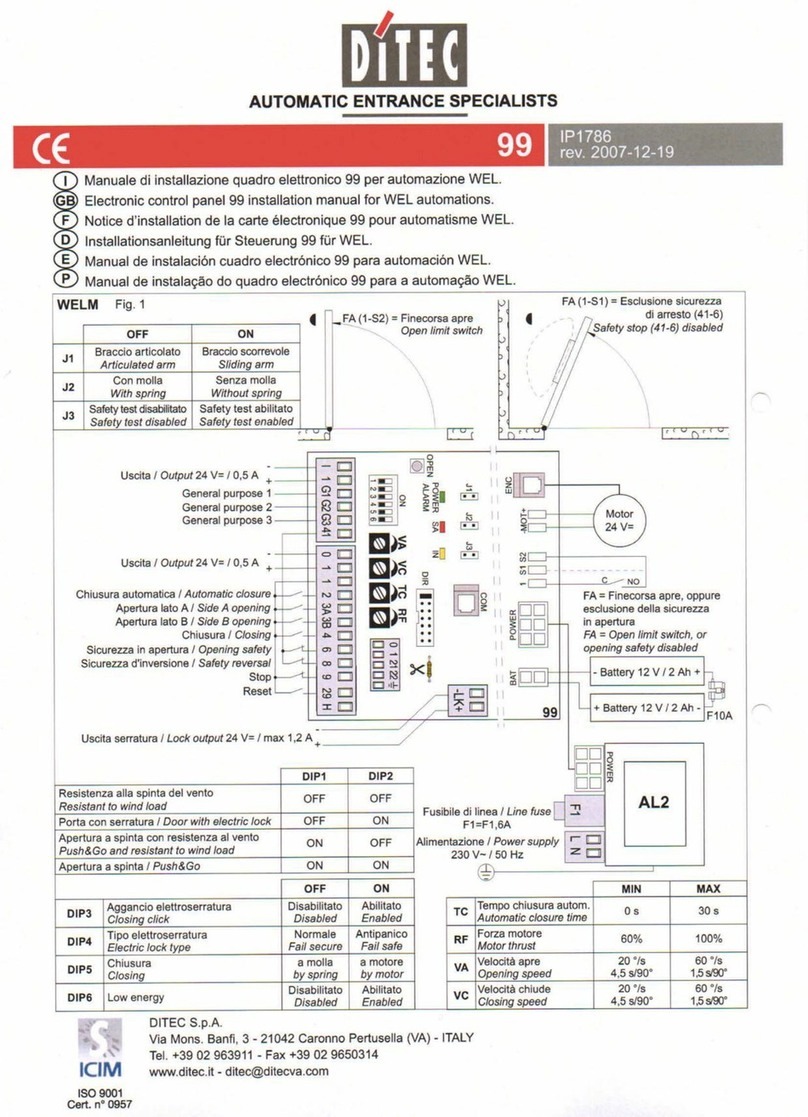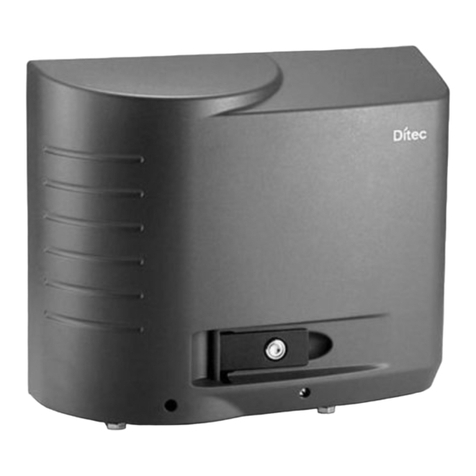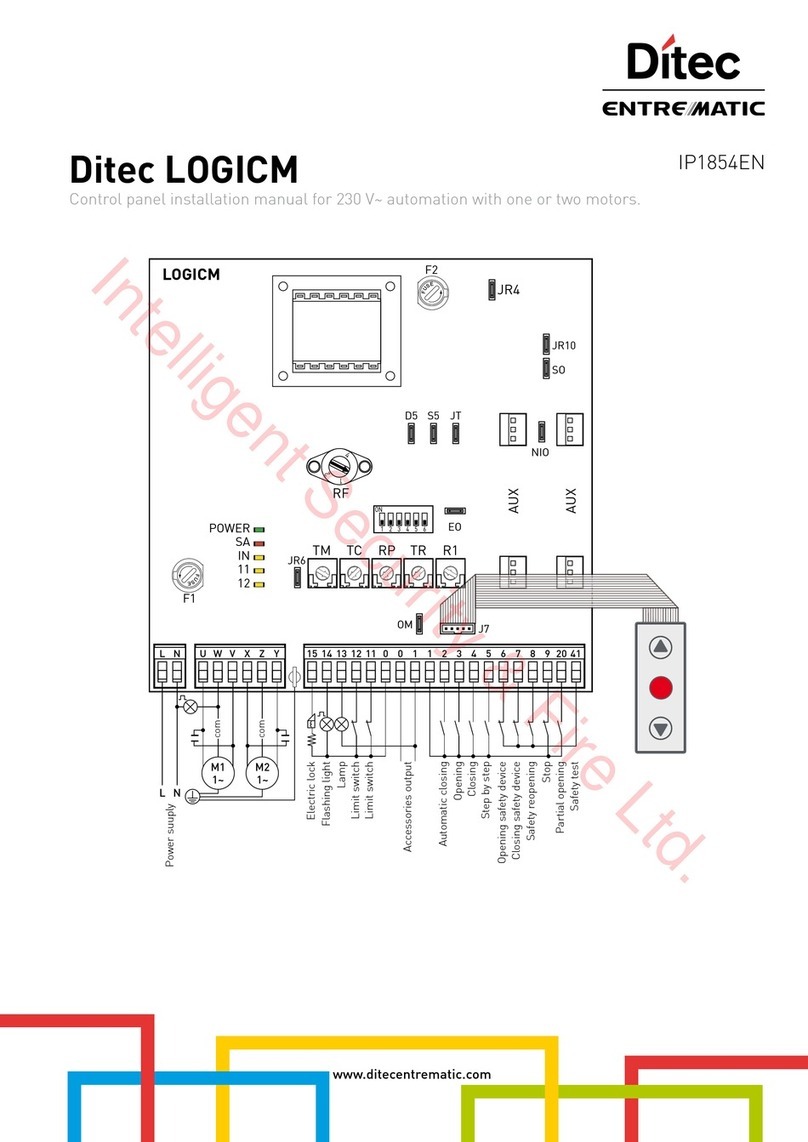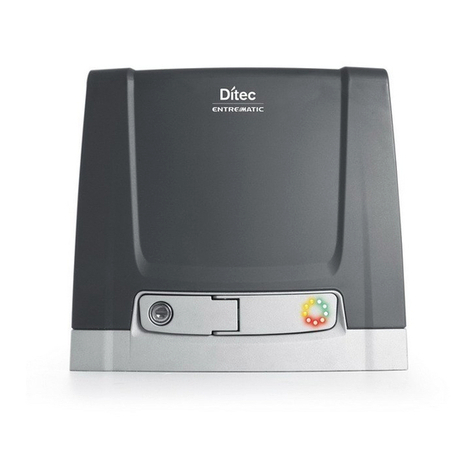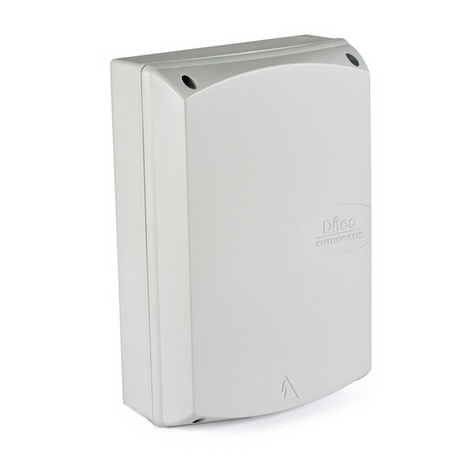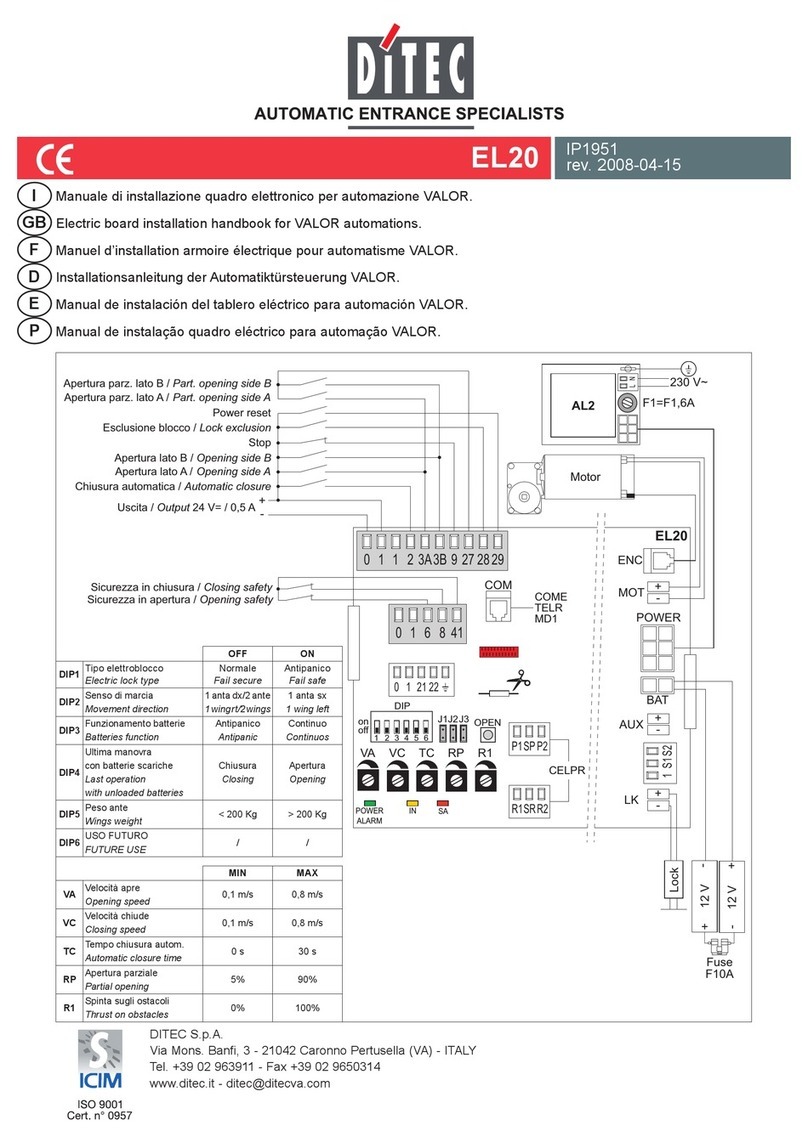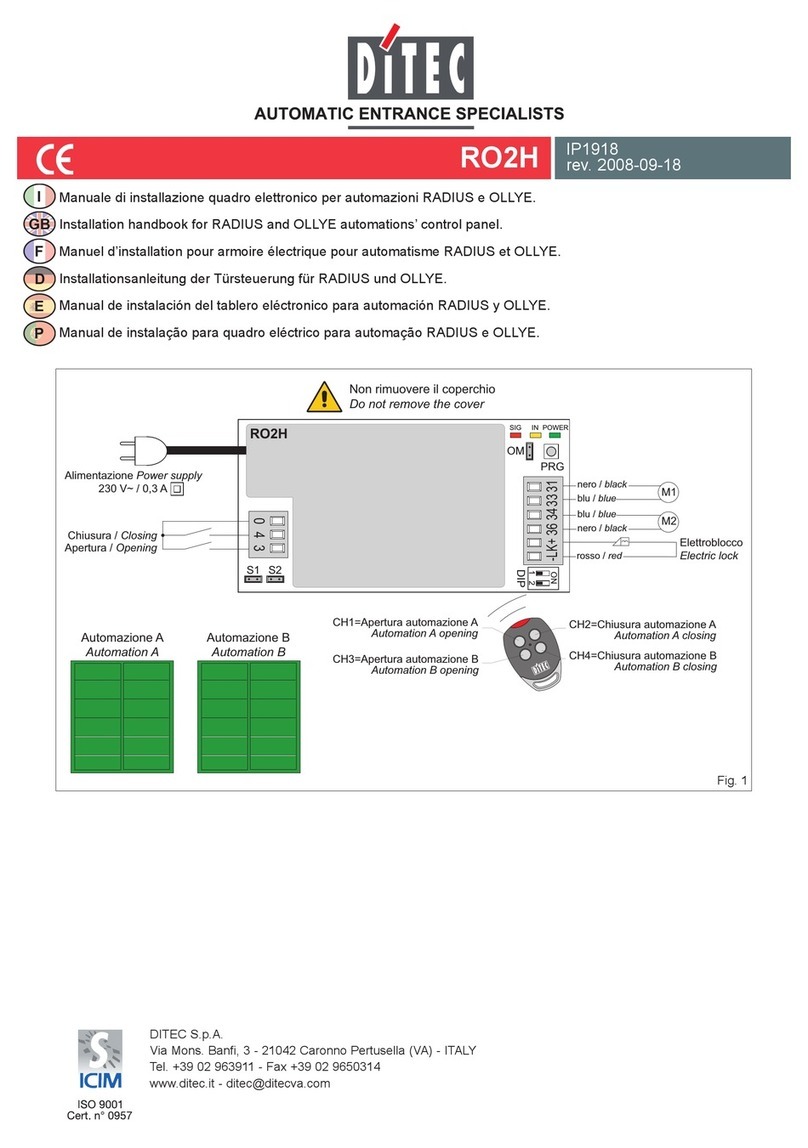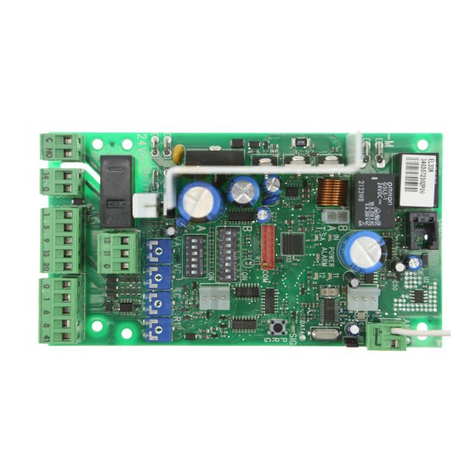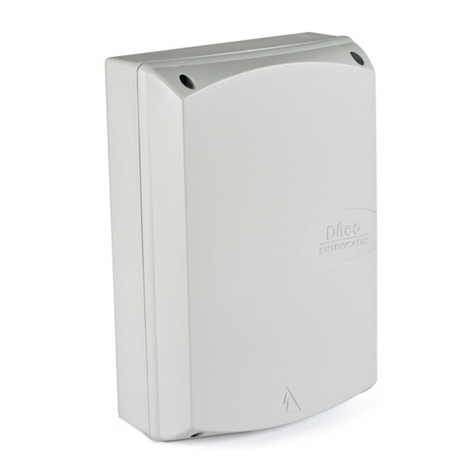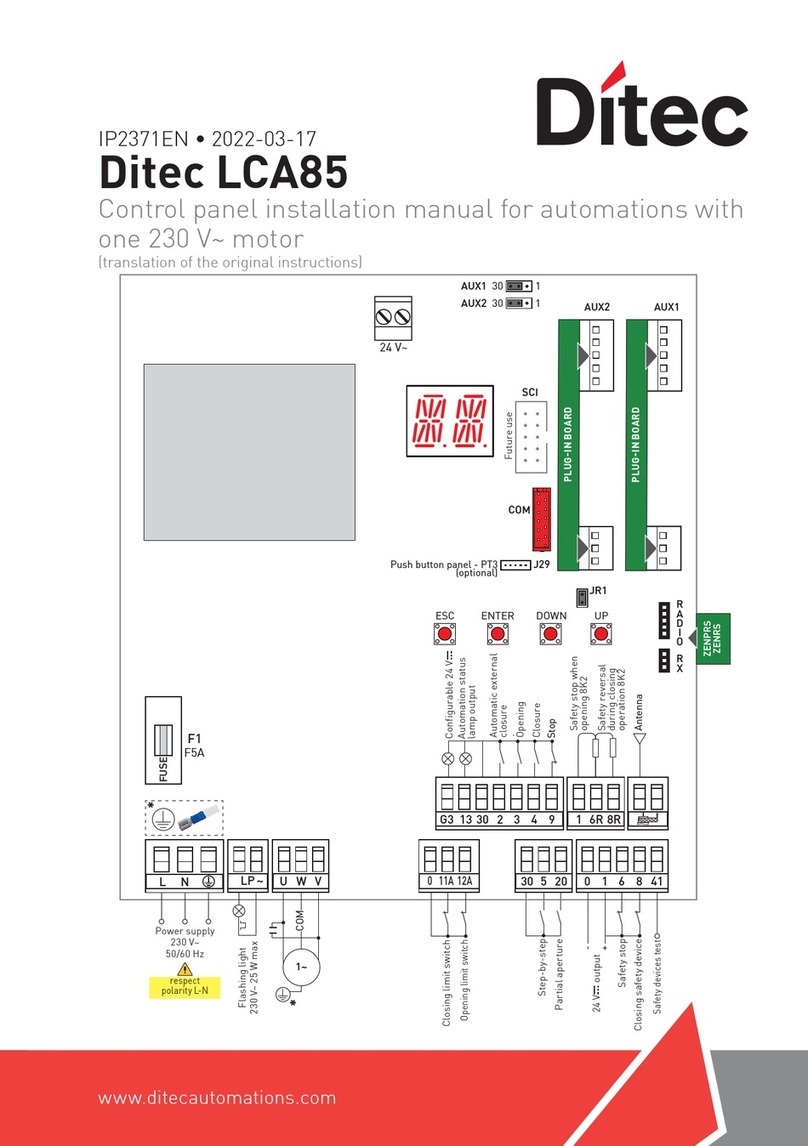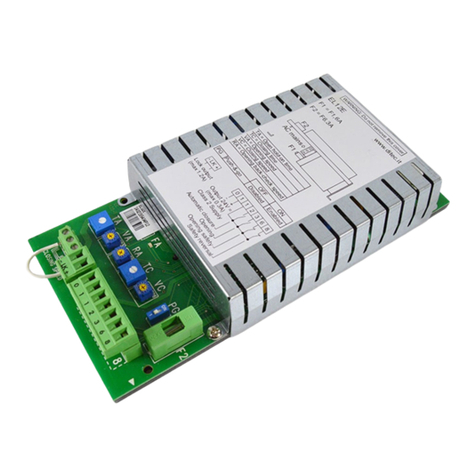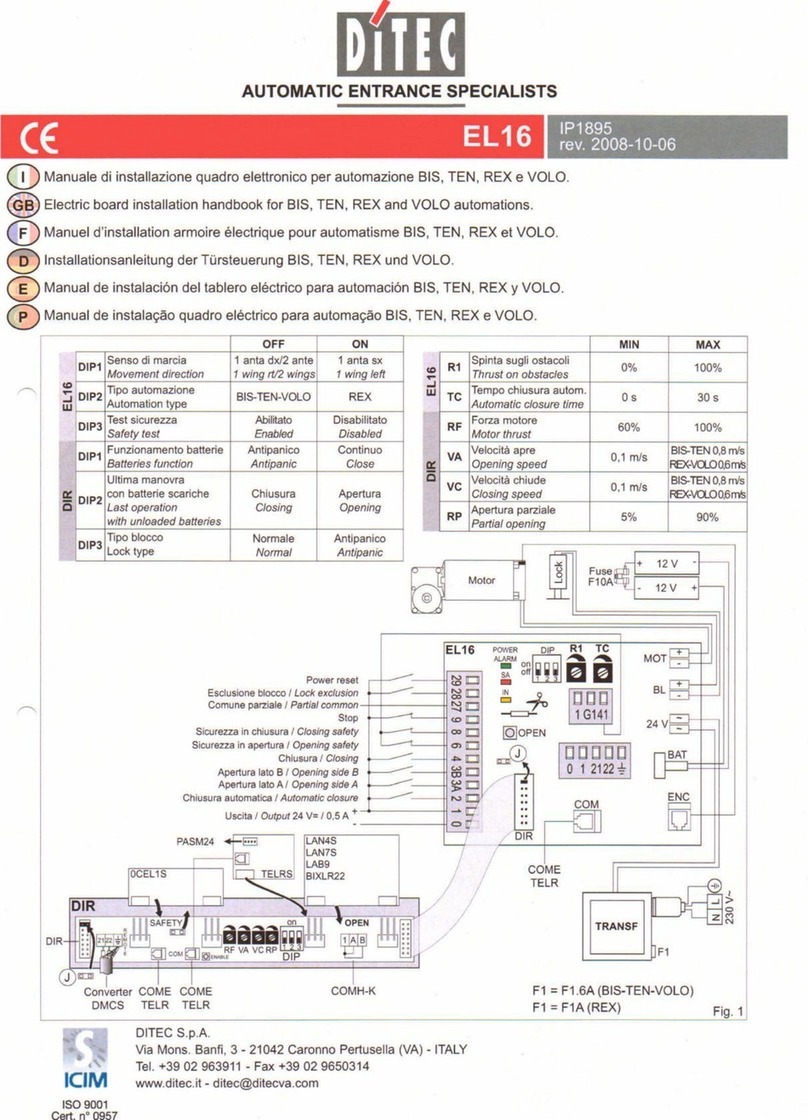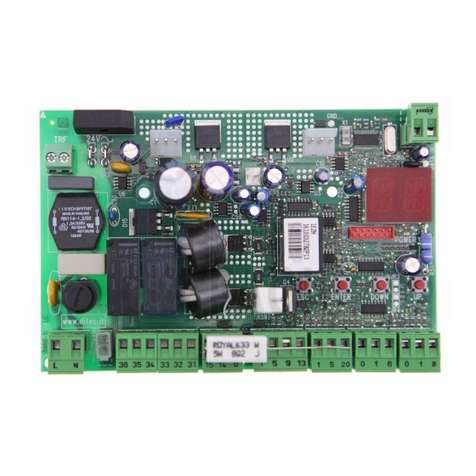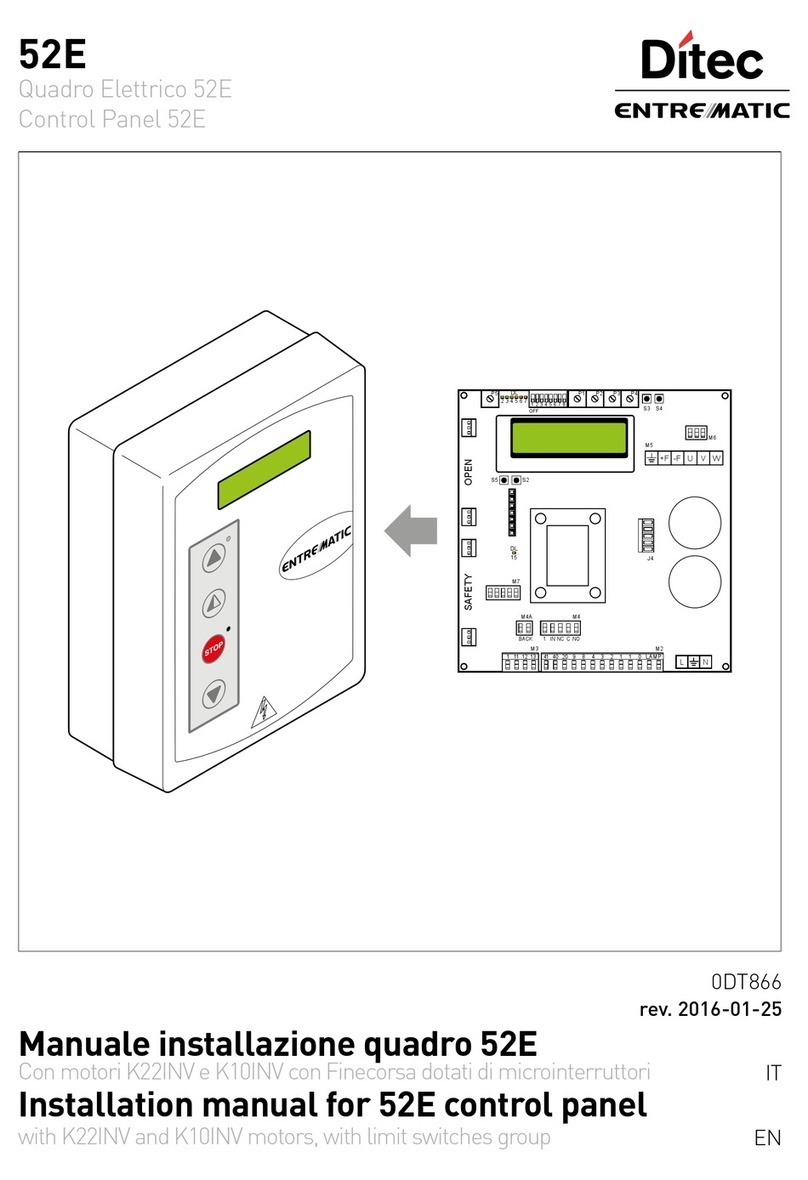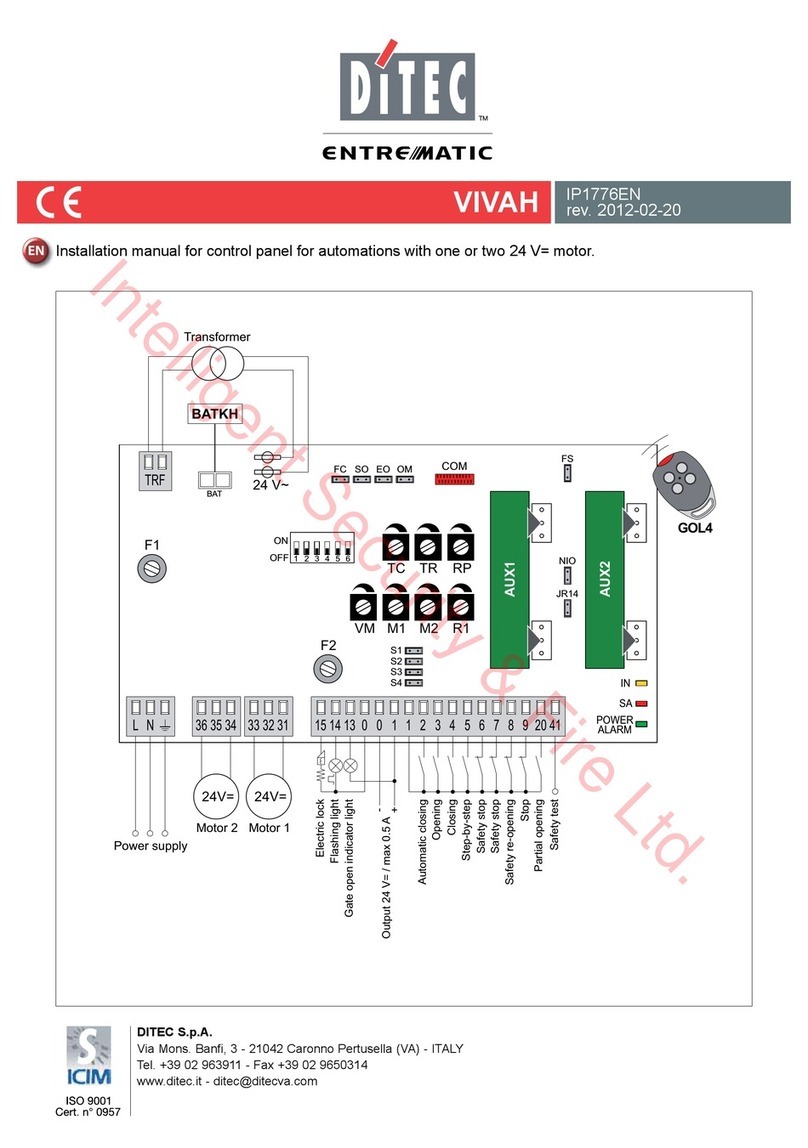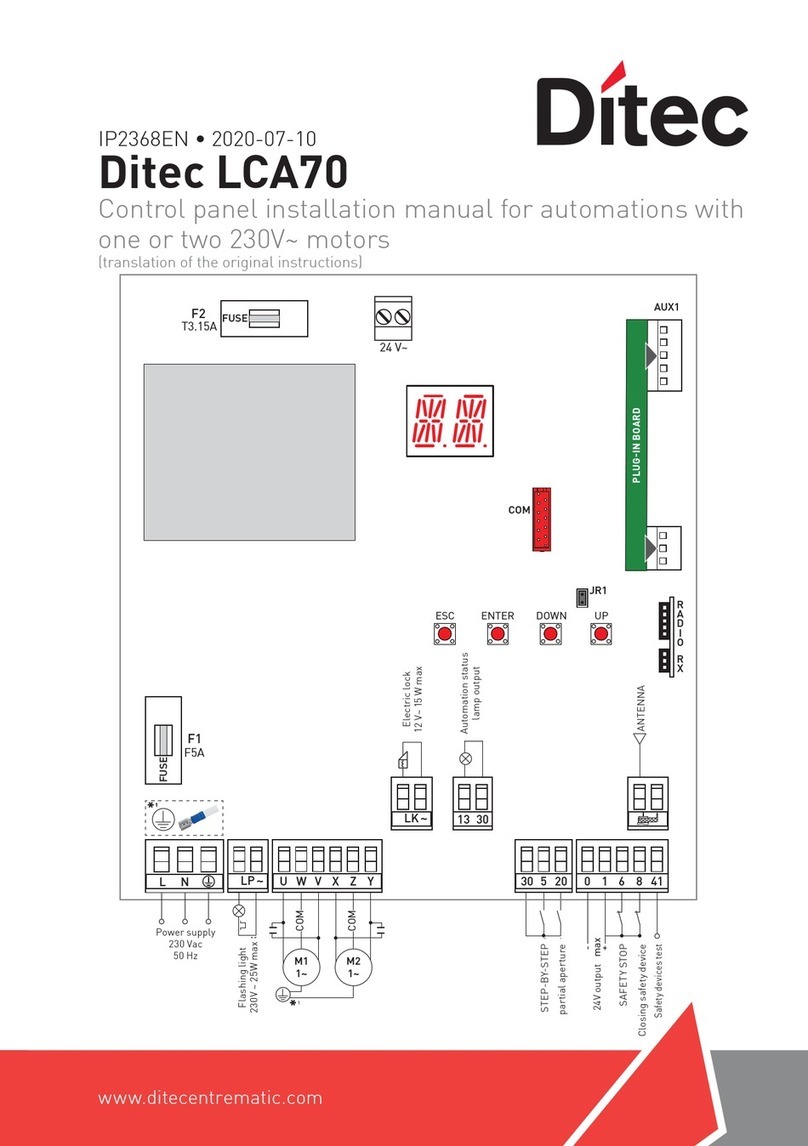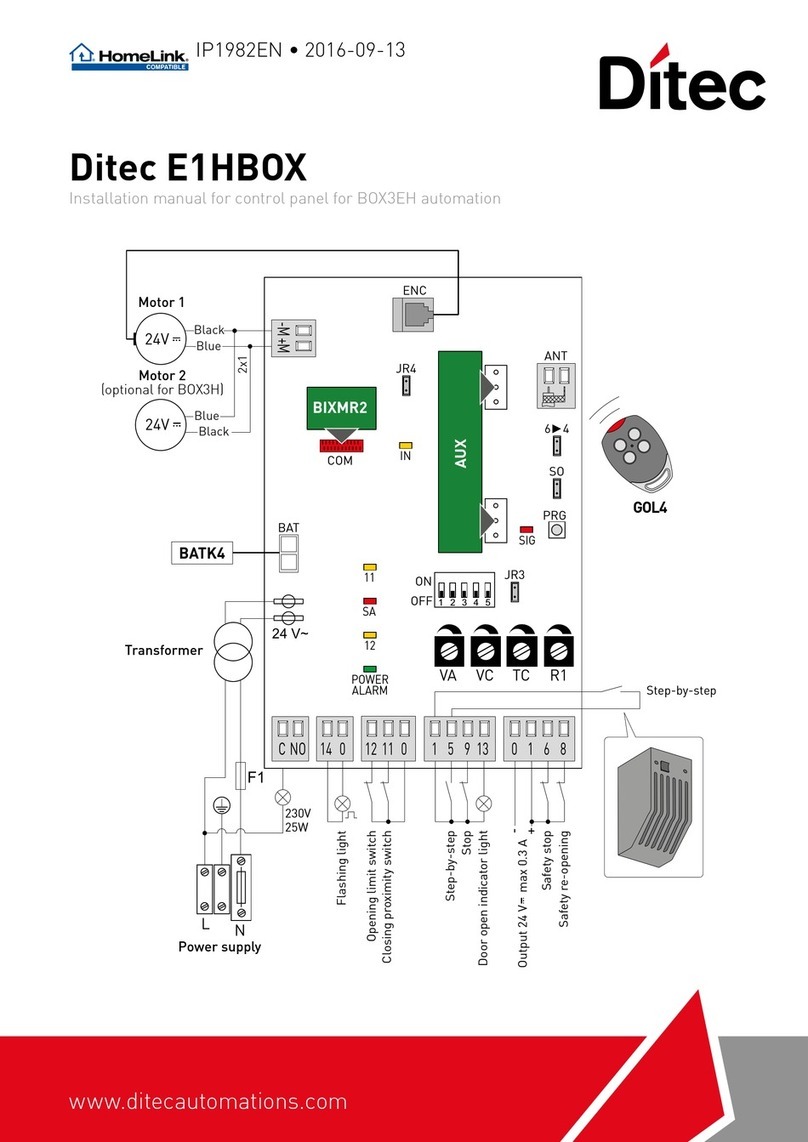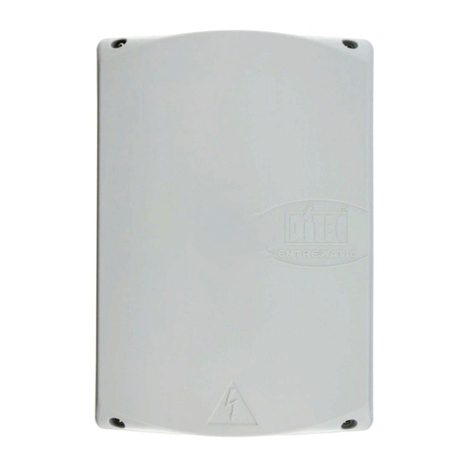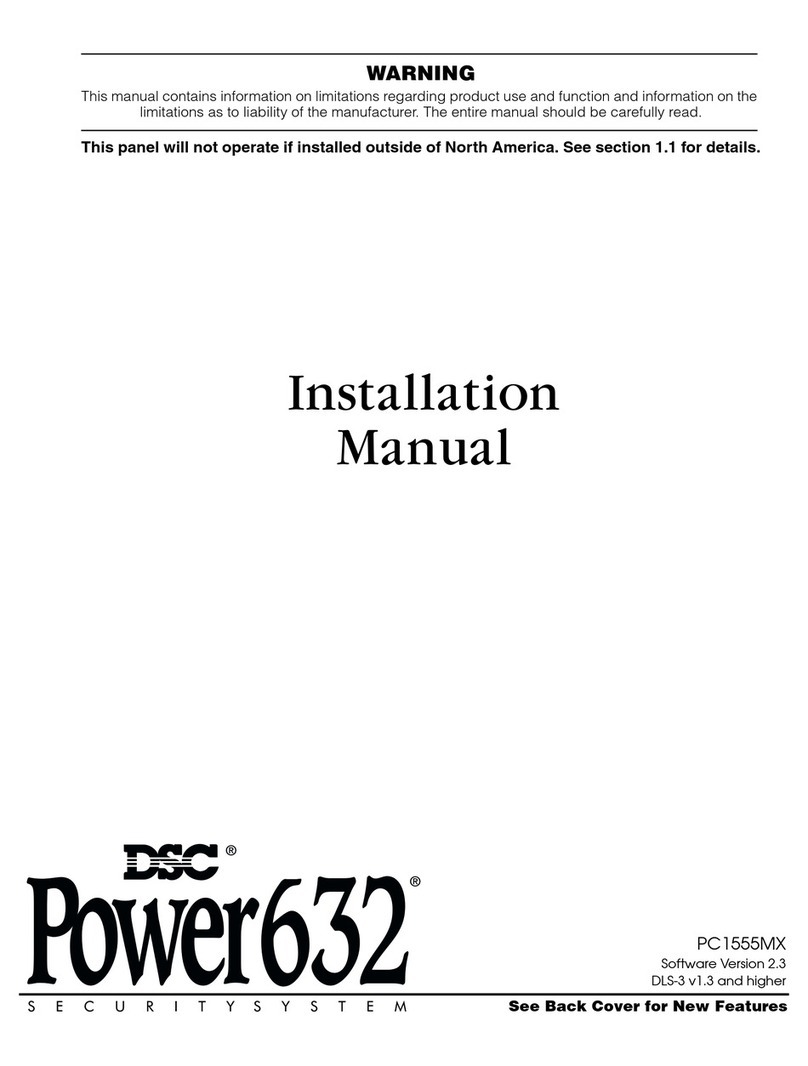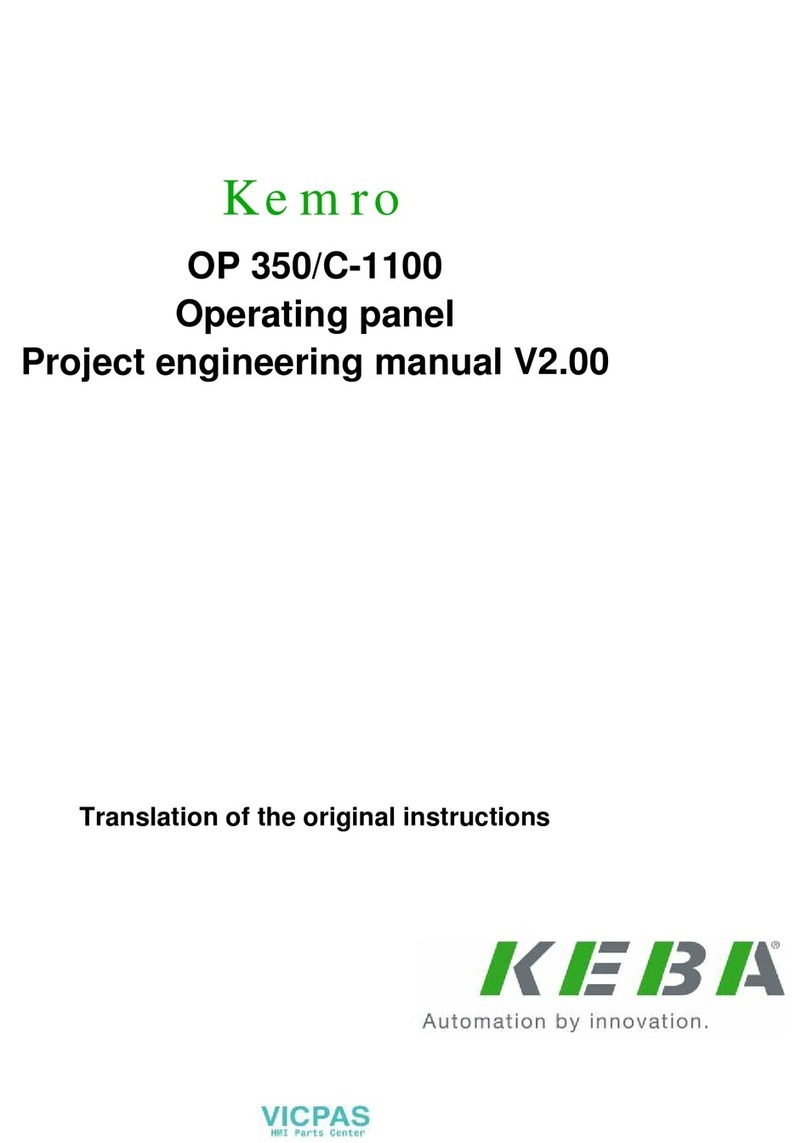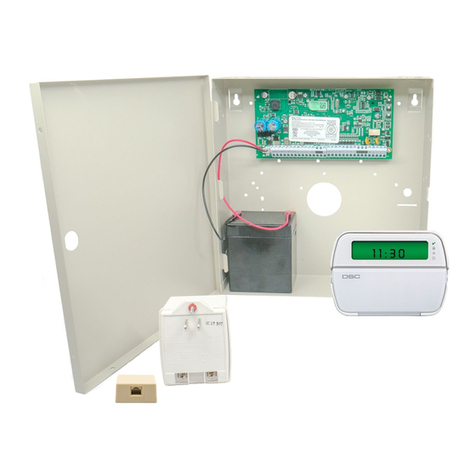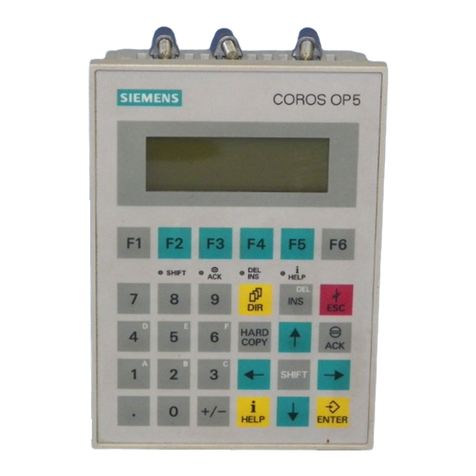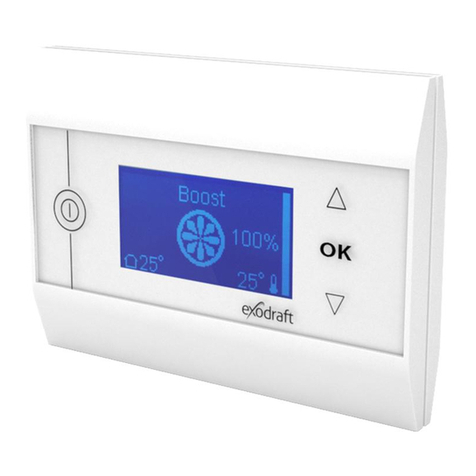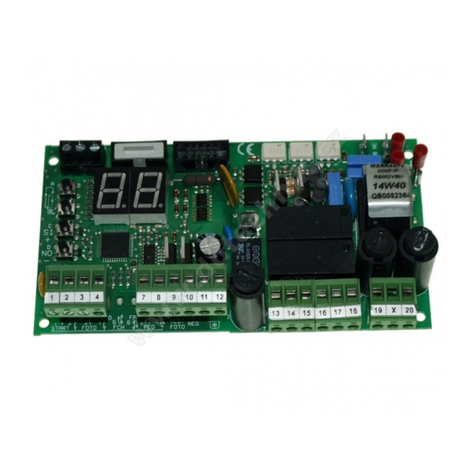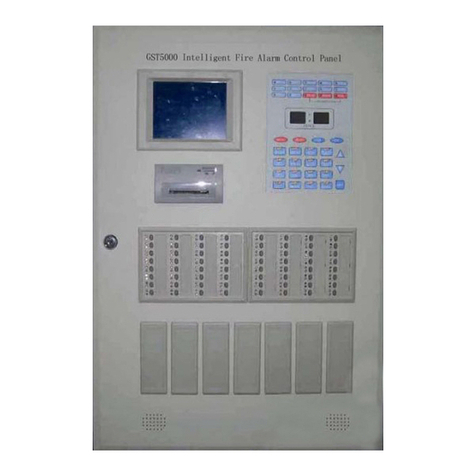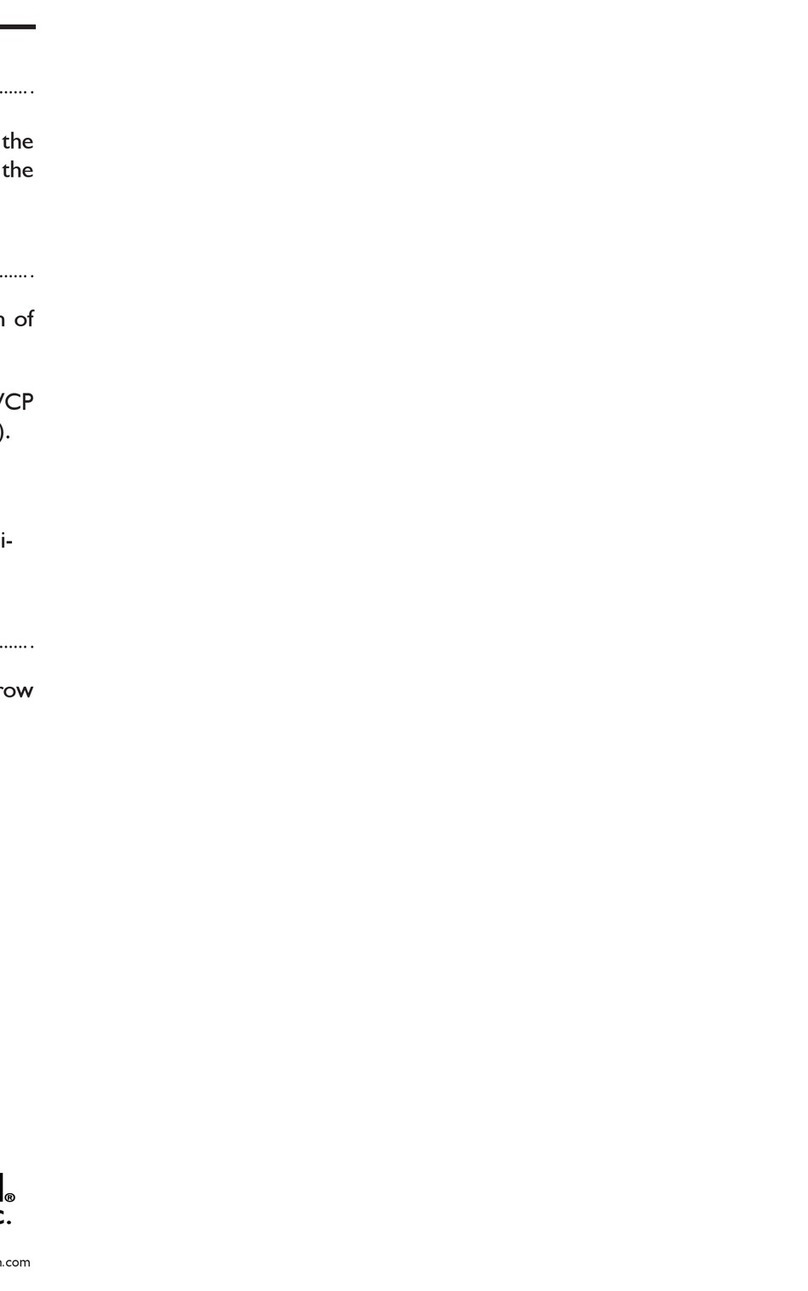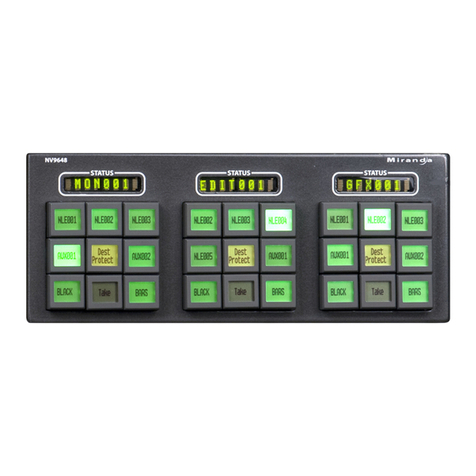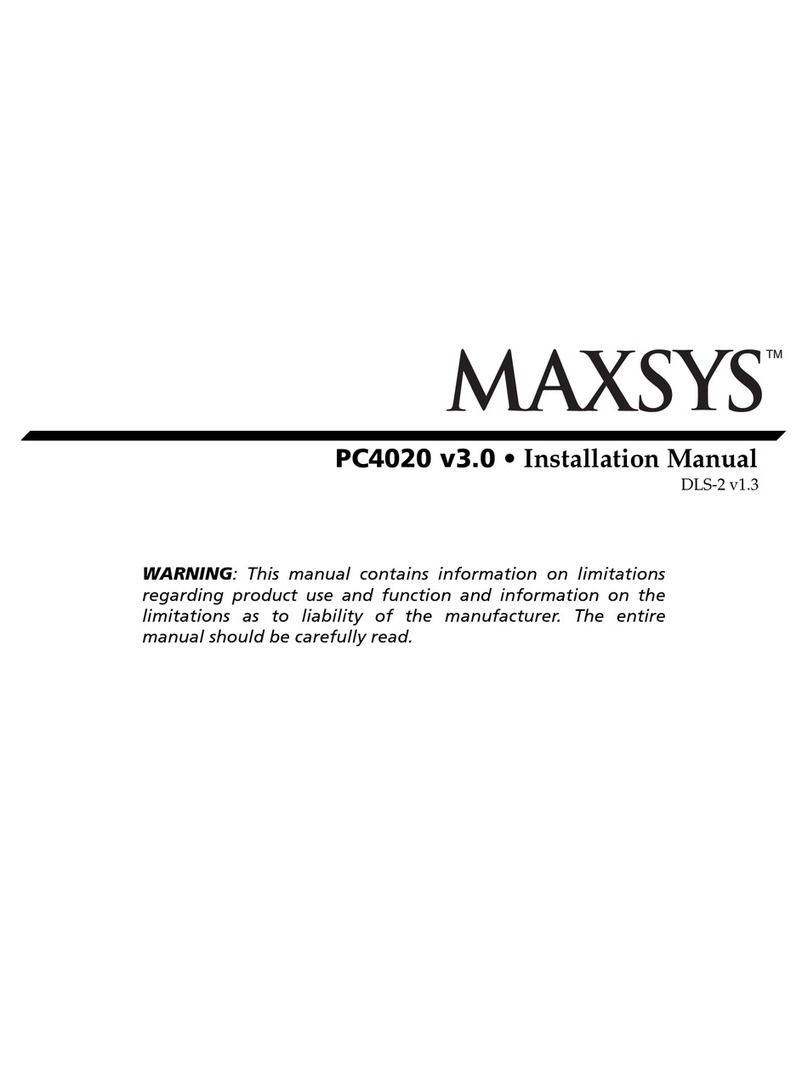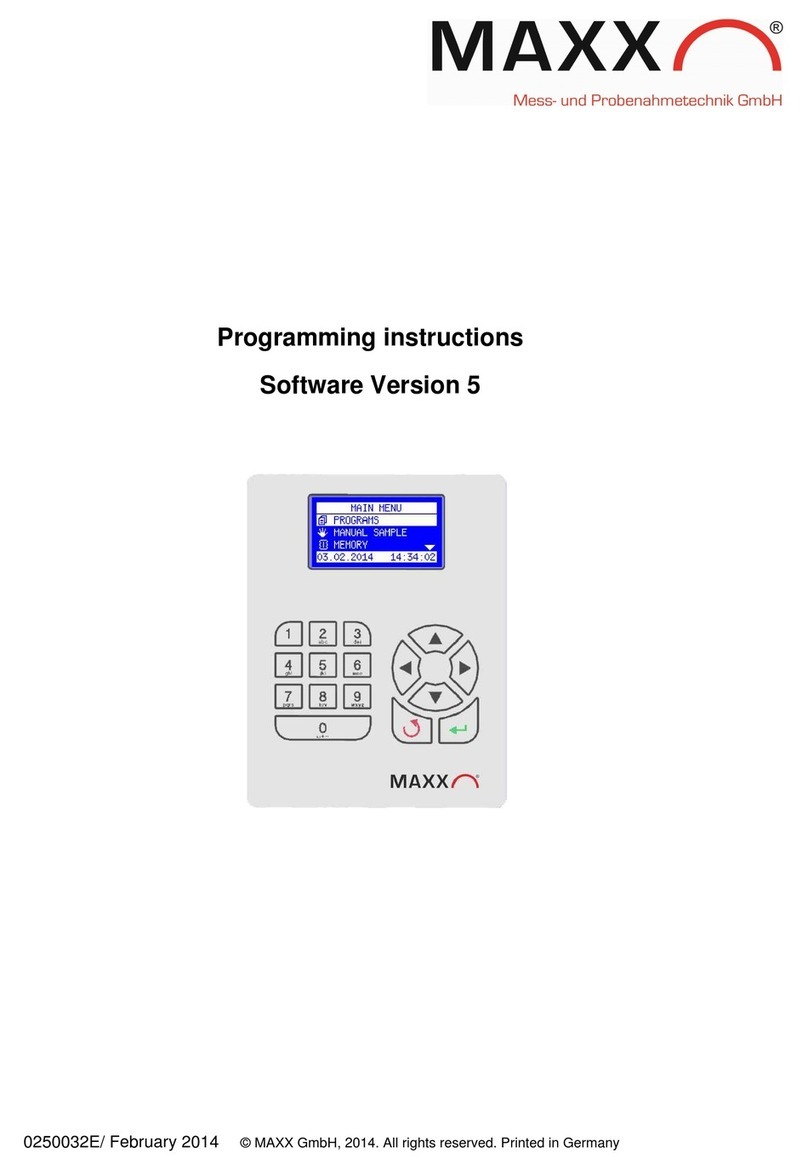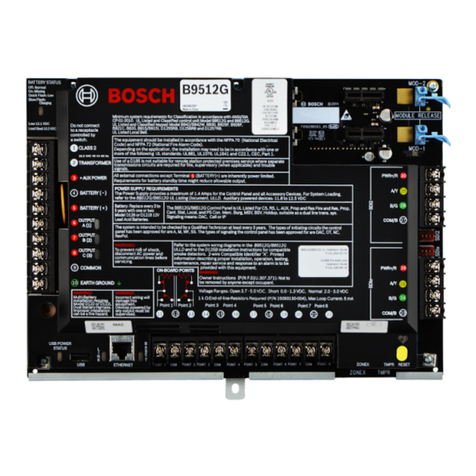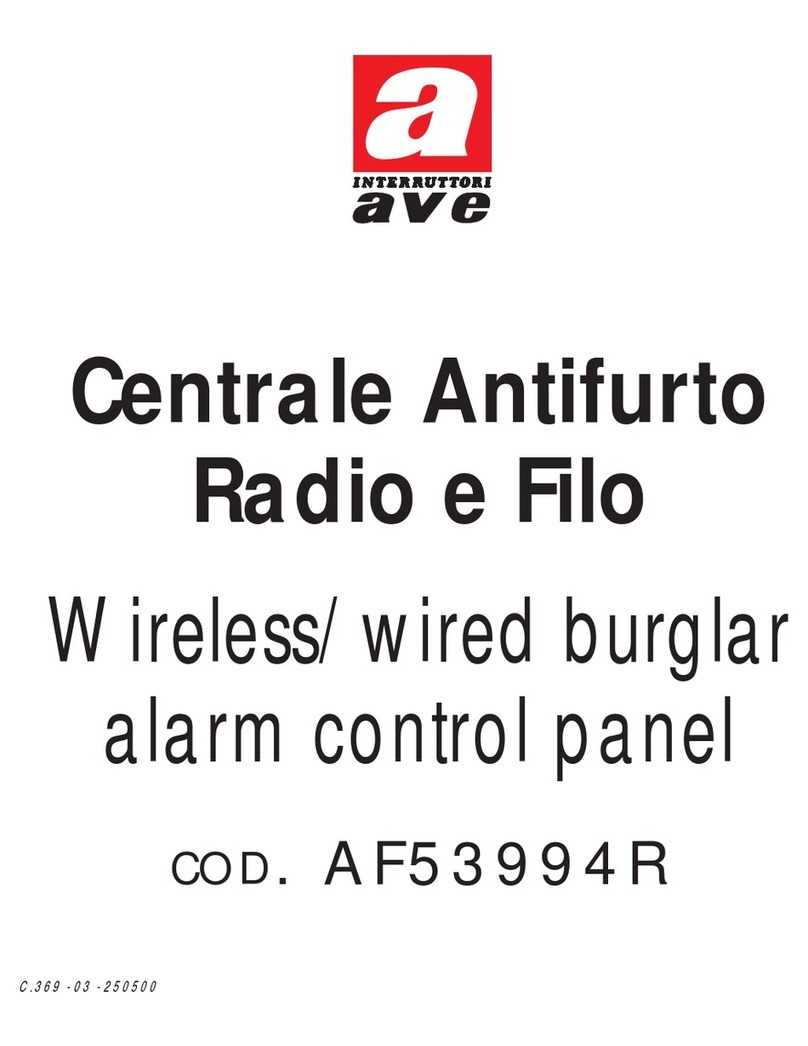DITEC VIVAH User manual

DITEC S.p.A.
Via Mons. Banfi, 3 - 21042 Caronno Pertusella (VA) - ITALY
Tel. +39 02 963911 - Fax +39 02 9650314
www.ditec.it - [email protected]
VIVAH - VIVAHJ IP1776
rev. 2006-04-11
I
P
E
D
F
GB
Manuale di installazione quadro elettronico per automazione 24 V= a 1 o 2 motori.
Installation manual for control panel for 24 V= automation with 1 or 2 motors.
Manuel d’installation d’une armoire électrique pour automatisation 24 V= à 1 ou 2 moteures.
Installationsanleitung der ein- oder zweimotorigen Torsteuerung 24 V=.
Manual de instalación del tablero eléctrico para automación 24 V= a 1 o 2 motores.
Manual de instalação do quadro eléctrico para automação 24 V= com 1 o 2 motores.
131415 0 0 1 1 2 3 4 5 6 7 8 9 20 41 3436 35L N 33 32 31
-+ + -
POWER
ALARM
SA
IN
OPEN
OPEN
OM
Not Used
FCSOEO
FS
NIO
M1VM
TRF
F1
F2 = F2,5A
M2 R1
TC TR RP
1
ON
23456
-B+B
24V~
Lampada / Lamp
Lampeggiante / Flashing light
Elettroserratura / Electric lock
Passo-passo / Step by step
Sicurezza in apertura / Safety while opening
Riapertura di sicurezza / Reversal safety contact
Sicurezza in chiusura / Safety while closing
Chiusura automatica / Automatic closing
Apertura / Opening
Chiusura / Closing
Stop - autoritenuta / Stop - Control hold down
Apertura parziale / Partial opening
NON USARE / NOT USE
-
+
Uscita / Output 24 V= / 0,5 A
M1
=
M2
=
Alimentazione
Power supply
S4
S3
S2
S1
F25A
BATK2
+ BATTERY 12V 6,5 Ah -
- BA
TTERY 12V 6,5 Ah +
Fig. 1

2
VIVAH - IP1776
IAVVERTENZE GENERALI PER LA SICUREZZA
Il presente manuale di installazione è rivolto esclusi-
vamente a personale professionalmente competente.
L’installazione, i collegamenti elettrici e le regolazioni devono
essere effettuati nell’osservanza della Buona Tecnica e in ot-
temperanza alle norme vigenti. Leggere attentamente le istru-
zioni prima di iniziare l’installazione del prodotto. Una errata
installazione può essere fonte di pericolo. I materiali dell’imbal-
laggio (plastica, polistirolo, ecc.) non vanno dispersi nell’am-
biente e non devono essere lasciati alla portata dei bambini in
quanto potenziali fonti di pericolo. Prima di iniziare l’installazio-
ne verificare l’integrità del prodotto. Non installare il prodotto in
ambiente e atmosfera esplosivi: presenza di gas o fumi infiam-
mabili costituiscono un grave pericolo per la sicurezza. I dispo-
sitivi di sicurezza (fotocellule, coste sensibili, stop di emergen-
za, ecc.) devono essere installati tenendo in considerazione: le
normative e le direttive in vigore, i criteri della Buona Tecnica,
l’ambiente di installazione, la logica di funzionamento del siste-
ma e le forze sviluppate dalla porta o cancello motorizzati.
Prima di collegare l’alimentazione elettrica accertarsi che
i dati di targa siano rispondenti a quelli della rete di di-
stribuzione elettrica. Prevedere sulla rete di alimentazione un
interruttore / sezionatore onnipolare con distanza d’apertura
dei contatti uguale o superiore a 3 mm. Verificare che a monte
dell’impianto elettrico vi sia un interruttore differenziale e una
protezione di sovracorrente adeguati. Quando richiesto, colle-
gare la porta o cancello motorizzati a un’efficace impianto di
messa a terra eseguito come indicato dalle vigenti norme di
sicurezza.
Durante gli interventi di installazione, manutenzione e ripara-
zione, togliere l’alimentazione prima di aprire il coperchio per
accedere alle parti elettriche.
La manipolazione delle parti elettroniche deve essere
effettuata munendosi di bracciali conduttivi antistatici col-
legati a terra. Il costruttore della motorizzazione declina ogni
responsabilità qualora vengano installati componenti incom-
patibili ai fini della sicurezza e del buon funzionamento. Per
l’eventuale riparazione o sostituzione dei prodotti dovranno es-
sere utilizzati esclusivamente ricambi originali.
AVVERTENZE DI INSTALLAZIONE
Fissare il quadro elettrico in modo permanente. Forare il con-
tenitore del quadro elettrico nel lato inferiore per il passaggio
dei cavi. Se accessibili, bloccare i cavi medianti opportuni pres-
sacavi (non di nostra fornitura). Mantenere separati di almeno
8 mm i conduttori di linea dai conduttori motori e comandi nei
punti di connessione alle morsettiere (per esempio con fascet-
te). Collegare insieme i conduttori di protezione (colore giallo/
verde) della linea, del trasformatore e del quadro elettronico
mediante il morsetto in dotazione. Al termine dell’installazione
richiudere il contenitore.
DICHIARAZIONE CE DI CONFORMITÀ
Fabbricante: DITEC S.p.A. - via Mons. Banfi, 3
21042 Caronno Pertusella (VA) – ITALY.
Dichiara che il quadro elettrico tipo VIVAH è conforme alle con-
dizioni delle seguenti direttive CE:
Direttiva bassa tensione 73/23/CEE;
Direttiva EMC 89/336/CEE.
Caronno Pertusella, Fermo Bressanini
21-10-2005 (Presidente)
DATI TECNICI
VIVAH VIVAHJ
Alimentazione 230 V~ / 50-60 Hz 120 V~ / 50-60 Hz
Fusibile F1 F2A F4A
Uscita motore 24 V=
2x12 A max
24 V=
2x12 A max
Alimentazione accessori 24 V= / 0,5 A 24 V= / 0,5 A
Temperatura -20° C / +55° C -20° C / +55° C
Grado di protezione IP55 IP55
Dimensioni 238x357x120 238x357x120
186
238
357
328
120
Fig. 2
APPLICAZIONI
Tutti i diritti sono riservati
I dati riportati sono stati redatti e controllati con la massima
cura. Tuttavia non possiamo assumerci alcuna responsabilità
per eventuali errori, omissioni o approssimazioni dovute ad esi-
genze tecniche o grafiche.

3VIVAH - IP1776
I
1. COLLEGAMENTI ELETTRICI
1.1 Comandi
Comando Funzione Descrizione
1 2 N.O. CHIUSURA AUTOMATICA Un contatto permanente abilita la chiusura automatica.
1 3 N.O. APRE Attiva la manovra di apertura.
1 4 N.O. CHIUDE Attiva la manovra di chiusura.
1 5 N.O. PASSO PASSO Attiva una manovra in chiusura o apertura in sequenza: apre-stop-
chiude-apre. Attenzione: se la chiusura automatica è abilitata, lo
stop non è permanente ma della durata impostata da TC.
1 6 N.C. SICUREZZA IN APERTURA Arresta e/o impedisce la manovra di apertura con manovra di di-
simpegno di entrambe le ante. (Vedi regolazioni TC capitolo 1.4).
1 7 N.C. SICUREZZA IN CHIUSURA Arresta e/o impedisce la manovra di chiusura con manovra di di-
simpegno di entrambe le ante. (Vedi regolazioni TC capitolo 1.4).
1 8 N.C. SICUREZZA DI
INVERSIONE
Provoca l’inversione del movimento (riapertura) durante la fase di
chiusura.
Ad automazione ferma e ponticello SO chiuso, impedisce qualun-
que manovra, sia di apertura che di chiusura.
Ad automazione ferma e ponticello SO tagliato, impedisce solo la
manovra di chiusura.
1 9 N.C. STOP - AUTORITENUTA Il contatto 1-9 aperto provoca l’arresto del movimento e abilita la
funzione a uomo presente.
In questa condizione, i comandi di apertura (1-3/1-20) e di chiu-
sura (1-4) funzionano solo se mantenuti premuti, al loro rilascio
l’automazione si ferma.
Le eventuali sicurezze presenti effettuano l’arresto e il comando
passo-passo e la chiusura automatica sono disabilitati.
ARRESTO DI EMERGENZA Per ottenere un arresto totale in seguito all’apertura del contatto
1-9 (ad esempio l’arresto di emergenza), collegare i comandi di
apertura ai morsetti 9-3, 9-20 e i comandi di chiusura ai morsetti
9-4.
1 20 N.O. APERTURA PARZIALE Attiva una manovra di apertura parziale dell’anta comandata dal
motore 1, la cui durata, è stabilita mediante il trimmer RP, in se-
quenza: apertura parziale-stop-chiude-apertura parziale.
Attenzione: se la chiusura automatica è abilitata, lo stop non è
permanente ma della durata impostata da TC.
41 NON COLLEGARE - NON UTILIZZARE
SCHEDA INNESTO
(OPEN)
PASSO-PASSO / APRE Il quadro elettronico è provvisto di due sedi per schede ad innesto,
tipo ricevitori radio, spire magnetiche, etc. L’azione della scheda è
selezionata dal DIP1 (OFF = 1-5; ON = 1-3).
ATTENZIONE: Ponticellare tutti i contatti N.C. se non utilizzati. I morsetti con numero uguale sono equivalenti. La garanzia di
funzionamento e le prestazioni dichiarate si ottengono solo con accessori e dispositivi di sicurezza DITEC.
1.2 Costa di sicurezza autocontrollata SOFA1-SOFA2
USO FUTURO

4
VIVAH - IP1776
I1.3 Uscite e accessori
Uscita Valore Descrizione
1 +
0 -
24V= / 0,5 A Alimentazione accessori. Per alimentazione accessori esterni, compresa lampada
stato automazione. Uscita protetta elettronicamente.
0 14 24V= / 50 W
(2 A)
Lampeggiante (LAMPH) con DIP6=OFF. Si attiva contemporaneamente alla manovra
di apertura e chiusura. Per il prelampeggio vedi DIP5. Uscita protetta dal fusibile F2.
0 14 24V= / 25 W max.
(1 A)
Luce di cortesia con DIP6=ON. E’ possibile collegare una luce di cortesia che si atti-
va per 180 s al ricevimento di ogni comando di apertura (totale o parziale) o chiusura.
Uscita protetta dal fusibile F2.
0 15 24V= / 1,2 A Elettroblocco 24 V. Uscita protetta dal fusibile F2.
0 15 12V~ / 15 W Elettroserratura 12 V. Collegare in serie la resistenza da 8,2 Ω / 5 W in dotazione.
Uscita protetta dal fusibile F2.
1 13 24V= / 3 W
(0,125 A)
Lampada stato automazione. La luce è spenta ad automazione chiusa, è accesa ad
automazione aperta, lampeggia durante le fasi di apertura e chiusura.
Kit batterie BATK2 (OPZIONALE). Collegando il kit batterie BATK2 si garantisce il funzionamento in modo continuità anche in
mancanza di tensione di rete. Il quadro elettronico collega la batteria solo in presenza di rete e la mantiene carica; la utilizza in
tampone o in assenza di rete e la stacca quando la tensione scende sotto i 22 V dopo 60 s (ad automazione ferma). Per caricare
le batterie, collegare la rete e il kit batterie almeno 30 min. prima di avviare l’impianto. Per disalimentare il quadro elettronico si
deve togliere l’alimentazione e scollegare le batterie.
Attenzione: per consentire la ricarica, il kit batterie deve essere sempre collegato al quadro elettrico. Verificare periodicamente
l’efficienza del kit batterie.
N.B.: la temperatura di funzionamento delle batterie ricaricabili è di circa +5°C/+40°C. Per garantire il corretto funzionamento del
prodotto è opportuno installare le batterie all’interno di ambienti climatizzati.
1.4 Trimmer
Trimmer Descrizione
M1 (M2)
MIN=5s MAX=30s
Regolazione tempo manovra motore 1 (2). Da 5 a 30 s (oppure da 5 a 45 s in riferimento alle
impostazioni del paragrafo 1.6).
La manovra di apertura / chiusura è schematizzata nei paragrafi 4 e 5: la manovra è composta da
una parte a velocità impostata con VM di durata M1 (M2) e dal rallentamento a velocità fissa sia in
apertura che in chiusura. In apertura tale rallentamento dura al massimo 10 s, in chiusura dura fino
al raggiungimento della battuta o dell’eventuale finecorsa di arresto (FC=OFF).
VM
MIN MAX
Regolazione velocità movimento. Regola la velocità dal minimo al massimo girando il trimmer in
senso orario. La velocità di chiusura è uguale a quella di apertura.
TR
MIN. 0 s
10 s
20 s
MAX. 30 s
Regolazione tempo di ritardo in chiusura motore 1 (M1).
In chiusura il motore 1 (M1) parte con un ritardo regolabile con TR da 0 a 30 s, rispetto a M2. In
apertura il motore 2 (M2) parte con 3 s di ritardo rispetto a M1. Se TR=MIN le ante partono contem-
poraneamente.
Attenzione: è consigliato impostare TR=MIN con ante senza sovrapposizione oppure impostare
TR>3 s con ante che si sovrappongono.
TC
MIN=0s MAX=120s
Regolazione tempo chiusura automatica. Da 0 a 120 s (con 1-2 chiuso).
Il conteggio inizia da automazione ferma per il tempo impostato da TC.
Con DIP2=OFF, dopo l’intervento di una sicurezza (1-6/1-7/1-8), il conteggio inizia al rilascio della
sicurezza stessa (ad esempio dopo il passaggio attraverso le fotocellule), e dura per la metà del
tempo impostato con TC.
Con DIP2=ON il conteggio inizia ad automazione aperta e dura per tutta la durata del tempo impo-
stato con TC.
Con contatto 1-2 aperto o 1-9 aperto la chiusura automatica è disabilitata. Chiudendo 1-2 si riabilita
la chiusura automatica. Se disabilitata da 1-9, la chiusura automatica si riabilita, una volta richiuso
il contatto 1-9, solo dopo un comando di apertura totale, parziale o passo-passo.
RP
MIN=10% MAX=100%
Regolazione apertura parziale motore 1 (M1).
Percentuale di apertura parziale da 10% a 100% del trimmer M1.
R1 Regolazione spinta sugli ostacoli. Il quadro elettronico è dotato di un dispositivo di sicurezza che
in presenza di un ostacolo:
- in apertura arresta il movimento con manovra di disimpegno;
- in chiusura, prima del rallentamento, inverte il movimento;
- in chiusura, durante il rallentamento, arreta il movimento (se FC=ON) oppure inverte il movimento
(se FC=OFF).
Con R1=MIN si ha la minima spinta sugli ostacoli; con R1=MAX si ha la massima spinta sugli osta-
coli.
MIN MAX

5VIVAH - IP1776
I
1.5 Dip-Switch, ponticelli, jumper
Descrizione OFF / / ON / /
DIP1 Modalità radio (*) Passo-passo (1-5) Apre (1-3)
DIP2 Rinnovo tempo chiusura automatica (*) 50% 100%
DIP3 Stato dell’automazione all’accensione
Indica come il quadro elettronico considera
l’automazione al momento dell’accensione
(oppure al ritorno di alimentazione dopo una
interruzione), indipendentemente dalla reale
posizione dell’automazione stessa.
(*) Aperto. Chiuso.
La chiusura automatica non può
essere il primo comando anche se
abilitata.
N.B.: se non viene usata la chiusura
automatica si consiglia di impostare
DIP3=ON.
DIP4 Sblocco elettroserratura (*) Disabilitato. Abilitato (posizione consigliata in
presenza di elettroserratura).
Funzionamento elettroblocco (24 V)
Attenzione: solo con ponticello EO=OFF
e con automazioni tipo BOX3SH e DOK-E
(vedi capitolo 1.6).
Alimentato per tutta la manovra di
apertura e chiusura.
Alimentato solo ad automazione
chiusa.
DIP5 Prelampeggio fisso di 3 s (*) Disabilitato in apertura. Abilitato
solo con chiusura automatica con
TC maggiore di 3 s.
Abilitato sia in apertura che in chiu-
sura.
DIP6 Selezione 0-14 (*) Lampeggiante. Luce di cortesia.
EO Funzionamento elettroserratura Alimentata per 2,5 s all’inizio della
manovra di apertura.
(*) Alimentata per 1,2 s all’inizio della
manovra di apertura.
SO Funzionamento sicurezza 1-8 L’apertura del contatto 1-8 ad auto-
mazione ferma consente l’apertura
mediante i comandi 1-3, 1-5, 1-20 o
un comando radio.
(*) L’apertura del contatto 1-8 ad au-
tomazione ferma impedisce
qualsiasi manovra.
FC Selezione modalità finecorsa Finecorsa di arresto. (*) Finecorsa di rallentamento.
OM Tipologia automazione Automazione ad un motore oppure
con due motori in parallelo.
L’uscita motore 2 è equivalente al-
l’uscita motore 1: (36→33; 34→31).
(*) Automazione a due motori indi-
pendenti.
NIO Sistema elettronico antigelo Attiva automaticamente il sistema
che consente di mantenere l’efficien-
za dei motori anche a basse tempe-
rature ambiente. Per un corretto fun-
zionamento il quadro elettrico deve
essere alla stessa temperatura am-
biente dei motori.
(*) Disabilitato.
FS USO FUTURO
(* Impostazioni di fabbrica)
1.6 Selezione tipologia motore
Tipo automazione S1 S2 S3 S4
Impostazioni di fabbrica (N.C.) (N.C.) (N.C.) (N.C.)
Obbi3BH; ArcBH (N.O.) (N.C.) (N.C.) (N.C.)
Cubic30H; Cubic6H (N.C.) (N.O.) (N.C.) (N.C.)
Cubic30H + Cubic30LI (180°) (N.C.) (N.O.) (N.O.) (N.C.)
Luxo5BH (N.C.) (N.C.) (N.O.) (N.C.)
Box3SH (N.C.) (N.C.) (N.C.) (N.O.)
Arc1BH; Dor1BH (N.C.) (N.O.) (N.C.) (N.O.)
Facil3H (N.C.) (N.C.) (N.O.) (N.O.)
Dok-E (N.O.) (N.O.) (N.C.) (N.C.)

6
VIVAH - IP1776
I1.7 Segnalazioni
LED Acceso Lampeggiante
POWER ALARM Presenza alimentazione 24 V=. Errata selezione tipologia motore.
Un lampeggio lungo (1 s) indica l’eventuale man-
canza del/dei motore/i oppure l’erronea indicazione
del numero di motori presenti.
Un lampeggio corto (0,5 s) indica una errata sele-
zione del tipo di automazione (S1, S2, S3, S4).
La durata totale dei lampeggi è di 10 s, dopo di che
il quadro elettronico viene automaticamente reset-
tato.
SA Indica che almeno uno dei contatti 1-6, 1-7, 1-8 o
1-9 è aperto.
All’accensione il LED lampeggia indicando il con-
teggio delle manovre effettuate:
ogni lampeggio veloce = 1000 manovre
ogni lampeggio lento = 10000 manovre
IN Si accende ad ogni comando 1-3, 1-4, 1-5, 1-20 e
ad ogni variazione di Dip-switch e jumper.
/
1.8 Collegamento motori
M
o
t
o
r
2
M
o
t
o
r
1
M
o
t
o
r
1
M
o
t
o
r
2
Motore 2
Morsettiera quadro
elettronico
34 36
Obbi3BH Nero Blu
ArcBH-1BH Marrone Blu
Cubic30H Nero Blu
Cubic6H-6HV Nero Blu
Luxo5BH 31 / 34 33 / 36
Facil3H Blu Nero
Motore 1
Morsettiera quadro
elettronico
31 33
Obbi3BH Blu Nero
ArcBH-1BH Blu Marrone
Cubic30H Blu Nero
Cubic6H-6HV Blu Nero
Luxo5BH 31 / 34 33 / 36
Facil3H Nero Blu
Motore 1
Morsettiera quadro
elettronico
31 33
Obbi3BH Nero Blu
ArcBH-1BH Marrone Blu
Cubic30H Nero Blu
Cubic6H-6HV Nero Blu
Luxo5BH 31 / 34 33 / 36
Facil3H Blu Nero
Motore 2
Morsettiera quadro
elettronico
34 36
Obbi3BH Blu Nero
ArcBH-1BH Blu Marrone
Cubic30H Blu Nero
Cubic6H-6HV Blu Nero
Luxo5BH 31 / 34 33 / 36
Facil3H Nero Blu

7VIVAH - IP1776
I
2. AVVIAMENTO
ATTENZIONE Le manovre relative al punto 2.4 avvengono senza sicurezze.
E’ possibile variare i trimmer, dip-switch e jumper solo a cancello fermo.
2.1 Ponticellare le sicurezze (1-6/1-7/1-8) e lo stop (1-9).
2.2 Prima di procedere all’avviamento verificare il tipo di applicazione scelta in base agli esempi dei paragrafi successivi.
Selezionare il tipo di automazione mediante i jumper S1-S2-S3-S4. Se l’automazione è ad una anta tagliare il ponticello
OM.
2.3 Impostare TC e R1 al massimo e TR al minimo (oppure aumentare TR in caso di sormonto delle ante).
2.4 Dare alimentazione. N.B.: Invertire le polarità del motore in base al senso di apertura delle ante.
Attenzione: la prima manovra di chiusura dopo una interruzione di alimentazione, viene eseguita un’anta alla volta (prima
l’anta mossa dal motore M2 e poi l’anta mossa dal motore M1) e può avvenire a velocità ridotta (acquisizione).
2.5 Se si usano i microinterruttori di rallentamento, regolarli in apertura e chiusura e impostare M1 e M2 al massimo.
- Impostare VM e verificare la velocità in apertura e chiusura con successivi comandi 1-3 e 1-4.
Attenzione: se le ante arrivano in battuta sbattendo, anticipare l’intervento dei microinterruttori.
2.6 Se non si usano i microinterruttori impostare M1 (M2) e VM a metà.
- Con successivi comandi 1-3 e 1-4, impostare la velocità desiderata regolando VM.
N.B.: prima di dare un comando attendere che la manovra precedente sia completamente terminata.
Attenzione: l’automazione potrebbe sbattere sui fermi battuta.
- Dopo aver impostato la velocità desiderata, con successivi comandi 1-3 e 1-4 regolare il tempo di manovra M1 (M2) in
modo da ottenere un accostamento delle ante in bassa velocità sui fermi battuta.
Si consiglia di impostare un tempo di rallentamento che garantisca il completamento della manovra, anche in presenza di
attriti o altre condizioni ambientali avverse (vento, gelo, ecc.).
N.B.: per un regolare funzionamento è necessario che l’automazione si appoggi sulla battuta prima dell’arresto del motore,
in modo da compensare eventuali riduzioni di velocità.
2.7 Togliere i ponticelli e collegare le sicurezze (1-6/1-7/1-8) e lo stop (1-9) e verificarne il funzionamento.
2.8 Se necessario, regolare con TR il tempo di ritardo motore 1.
2.9 Se desiderato, collegare 1-2 e regolare con TC la chiusura automatica.
2.10 Impostare con R1 la spinta sugli ostacoli.
Attenzione: se l’anta che chiude per seconda (TR > MIN) incontra un ostacolo, entrambe le ante riaprono. La successiva
manovra di chiusura avviene un’anta alla volta.
N.B.: verificare che le forze operative della ante siano conformi a quanto richiesto dalle norme EN12453-EN12445.
2.11 Se desiderato, impostare con RP l’apertura parziale del motore 1.
2.12 Richiudere il contenitore con le 4 viti.

8
VIVAH - IP1776
I3. RICERCA GUASTI
Problema Possibile causa Intervento
L’automazione non apre e non chiude. Manca alimentazione. Verificare che il quadro elettrico sia ali-
mentato (il LED POWER ALARM deve
essere acceso).
Motore/i non collegato/i. Verificare il collegamento del/dei mo-
tore/i e verificare il ponticello OM (LED
POWER ALARM lampeggiante).
Selezione errata del tipo automazione. Verificare la corretta selezione dei
jumper S1, S2, S3, S4 (LED POWER
ALARM lampeggiante).
Accessori in corto circuito. Scollegare tutti gli accessori dai mor-
setti 0-1 (deve esserci la tensione di 24
V=) e ricollegarli uno alla volta.
Fusibile di linea bruciato. Sostituire il fusibile F1.
I contatti di sicurezza sono aperti.
(LED SA acceso).
Verificare che i contatti 1-6, 1-7, 1-8 e
1-9 siano chiusi (N.C.). Tra 0-6, 0-7, 0-8
e 0-9, misurando con il tester ci deve
essere la tensione di 24 V=.
I comandi di apertura/chiusura non fun-
zionano.
Verificare l’accensione del LED IN, ad
ogni comando 1-3, 1-4, 1-5, 1-20.
L’automazione apre ma non chiude. I contatti di sicurezza sono aperti.
(LED SA acceso).
Verificare che i contatti 1-6, 1-7, 1-8 e
1-9 siano chiusi (N.C.). Tra 0-6, 0-7, 0-8
e 0-9, misurando con il tester ci deve
essere la tensione di 24 V=.
Le fotocellule sono attivate.
(LED SA acceso).
Verificare la pulizia e il corretto funzio-
namento delle fotocellule.
Le sicurezze esterne non intervengono. La chiusura automatica non funziona. Verificare che il contatto 1-2 sia chiuso.
Collegamenti errati tra le fotocellule e il
quadro elettronico.
Collegare i contatti di sicurezza N.C. in
serie tra loro e levare gli eventuali pon-
ticelli presenti sulla morsettiera del qua-
dro elettronico.
Il lampeggiante non funziona.
L’elettroserratura non funziona.
Fusibile F2 bruciato. Sostituire il fusibile F2.

9VIVAH - IP1776
I
Quando il quadro elettronico VIVAH viene usato in applicazioni
per automazioni a due ante battenti, è possibile effettuare i
seguenti collegamenti:
- (Fig. 4.1) Utilizzo senza finecorsa
Collegare i motori come indicato in figura.
N.B.: durante la manovra di apertura le polarità +/- sono
quelle indicate in figura.
Impostare VM secondo la velocità desiderata.
Impostare M1 e M2 in modo da ottenere il rallentamento
dell’anta prima della battuta meccanica.
Con questi collegamenti, ciascuna anta si ferma sulla battuta
meccanica di apertura e chiusura.
Allo scadere del tempo impostato con M1/M2: in apertura il
tempo di rallentamento è di max. 10 s, in chiusura le ante
rallentano fino alla battuta meccanica.
- (Fig. 4.2) Utilizzo con finecorsa di rallentamento
Collegare i motori e i finecorsa di rallentamento come indicato
in figura.
[A] Finecorsa di rallentamento apre;
[C] Finecorsa di rallentamento chiude.
Impostare M1 e M2 = MAX.
Impostare VM secondo la velocità desiderata.
Con questi collegamenti, ciascuna anta si ferma sulla battuta
meccanica di chiusura e apertura.
Dopo l’intervento dei finecorsa di rallentamento: in apertura
e in chiusura il tempo di rallentamento è di max. 10 s.
- (Fig. 4.3) Utilizzo con finecorsa di arresto
Tagliare il ponticello FC.
Collegare i motori e i finecorsa di arresto come indicato in
figura.
[A] Finecorsa di arresto apre;
[C] Finecorsa di arresto chiude.
N.B.: è possibile installare anche un solo finecorsa per ogni
motore.
Impostare M1 e M2 < MAX.
Impostare VM secondo la velocità desiderata.
Impostare M1 e M2 in modo da ottenere il rallentamento
dell’anta prima dell’intervento dei finecorsa.
Con questi collegamenti, ciascuna anta si ferma quando
interviene il relativo finecorsa.
Allo scadere del tempo impostato con M1/M2: in apertura il
tempo di rallentamento è di max. 10 s, in chiusura le ante
rallentano fino al finecorsa di arresto.
4. ESEMPIO DI APPLICAZIONI PER BATTENTI A DUE MOTORI
3436 35 33 32 31
-+ + -
M1
=
M2
=
M1<MAX
M2<MAX
3436 35 33 32 31
-+ + -
M1
=
M1=MAX M2=MAX
AC
M2
=
AC
FC
M1<MAX M2<MAX
3436 35 33 32 31
-+ + -
M1
=
AC
M2
=
AC
Fig. 4.3
max. 10 s max. 10 s
M2 (VM)
M1(VM)
M2 (VM) M1(VM)
A
A
C
C
1N4007
Fig. 4.2
max. 10 s max. 10 s
VM
VM
VM VM
AA
C
C
max.
10 s
1N4007
max. 10 s max. 10 s
M2 (VM)
M1(VM)
M2 (VM) M1(VM)
Fig. 4.1

10
VIVAH - IP1776
I
Quando il quadro elettronico VIVAH viene usato in applicazioni
per automazioni ad una anta battente, per portoni scorrevoli
oppure per porte basculanti, è possibile effettuare i seguenti
collegamenti:
- (Fig. 5.1) Utilizzo senza finecorsa
Tagliare il ponticello OM.
Collegare il motore come indicato in figura.
N.B.: durante la manovra di apertura le polarità +/- sono
quelle indicate in figura.
Impostare VM secondo la velocità desiderata.
Impostare M1 in modo da ottenere il rallentamento dell’anta
prima della battuta meccanica.
Con questi collegamenti, l’anta si ferma sulla battuta mec-
canica di apertura e chiusura.
Allo scadere del tempo impostato con M1: in apertura il
tempo di rallentamento è di max. 10 s, in chiusura l’anta
rallenta fino alla battuta meccanica.
- (Fig. 5.2) Utilizzo con finecorsa di rallentamento
Tagliare il ponticello OM.
Collegare il motore e i finecorsa di rallentamento come indi-
cato in figura.
[A] Finecorsa di rallentamento apre;
[C] Finecorsa di rallentamento chiude.
Impostare M1 = MAX.
Impostare VM secondo la velocità desiderata.
Con questi collegamenti, l’anta si ferma sulla battuta mec-
canica di chiusura e apertura.
Dopo l’intervento del finecorsa di rallentamento: in apertura
e in chiusura il tempo di rallentamento è di max. 10 s.
- (Fig. 5.3) Utilizzo con finecorsa di arresto
Tagliare i ponticelli OM e FC.
Collegare il motore e i finecorsa di arresto come indicato in
figura.
[A] Finecorsa di arresto apre;
[C] Finecorsa di arresto chiude.
N.B.: è possibile installare anche un solo finecorsa.
Impostare M1 < MAX.
Impostare VM secondo la velocità desiderata.
Impostare M1 in modo da ottenere il rallentamento dell’anta
prima dell’intervento del finecorsa.
Con questi collegamenti, l’anta si ferma quando interviene
il finecorsa.
Allo scadere del tempo impostato con M1: in apertura il
tempo di rallentamento è di max. 10 s, in chiusura l’anta
rallenta fino al finecorsa di arresto.
5. ESEMPIO DI APPLICAZIONI PER AUTOMAZIONI A UN MOTORE
3436 35 33 32 31
-+ + -
M1
=
OM
M1<MAX
3436 35 33 32 31
-+ + -
M1
=
M1=MAX
AC
OM
M1<MAX
3436 35 33 32 31
-+ + -
M1
=
A
C
OM
FC
max. 10 s
M1(VM)
M1 (VM)
A
C
Fig. 5.3
1N4007
max. 10 s
max. 10 s
VM
VM
C
A
Fig. 5.2
1N4007
max. 10 s
M1(VM)
M1(VM)
Fig. 5.1

11 VIVAH - IP1776
I
Quando il quadro elettronico VIVAH viene usato in applicazioni
per automazioni per porte basculanti con due motori in paralle-
lo, è possibile effettuare i seguenti collegamenti:
- (Fig. 6.1) Utilizzo senza finecorsa
Tagliare il ponticello OM.
Collegare i motori come indicato in figura.
N.B.: durante la manovra di apertura le polarità +/- sono
quelle indicate in figura.
Impostare VM secondo la velocità desiderata.
Impostare M1 in modo da ottenere il rallentamento dell’anta
prima della battuta meccanica.
Con questi collegamenti, l’anta si ferma sulla battuta mec-
canica di apertura e chiusura.
Allo scadere del tempo impostato con M1: in apertura il
tempo di rallentamento è di max. 10 s, in chiusura l’anta
rallenta fino alla battuta meccanica.
- (Fig. 6.2) Utilizzo con finecorsa di rallentamento
Tagliare il ponticello OM.
Collegare il motore e i finecorsa di rallentamento come indi-
cato in figura.
[A] Finecorsa di rallentamento apre;
[C] Finecorsa di rallentamento chiude.
Impostare M1=MAX.
Impostare VM secondo la velocità desiderata.
Con questi collegamenti, l’anta si ferma sulla battuta mec-
canica di chiusura e apertura.
Dopo l’intervento del finecorsa di rallentamento: in apertura
e in chiusura il tempo di rallentamento è di max. 10 s.
(Fig. 6.3) Utilizzo con finecorsa di arresto
Tagliare i ponticelli OM e FC.
Collegare il motore e i finecorsa di arresto come indicato in
figura.
[A] Finecorsa di arresto apre;
[C] Finecorsa di arresto chiude.
N.B.: è possibile installare anche un solo finecorsa.
Impostare M1<MAX.
Impostare VM secondo la velocità desiderata.
Impostare M1 in modo da ottenere il rallentamento dell’anta
prima dell’intervento del finecorsa.
Con questi collegamenti, l’anta si ferma quando interviene
il finecorsa.
Allo scadere del tempo impostato con M1: in apertura il
tempo di rallentamento è di max. 10 s, in chiusura l’anta
rallenta fino al finecorsa di arresto.
6. ESEMPIO DI APPLICAZIONI PER BASCULANTI A DUE MOTORI IN PARALLELO
3436 35 33 32 31
�� � �
M1
=
M2
=
M1<MAX
OM
S4
S3
S2
S1
max. 10 s
M1(VM)
M1(VM)
Fig. 6.1
max. 10 s
max. 10 s
VM
VM
C
A
3436 35 33 32 31
-+ + -
M1
=
M2
=
OM
S4
S3
S2
S1
AC
M1=MAX
Fig. 6.2
1N4007
3436 35 33 32 31
-+ + -
M1
=
M2
=
OM
FC
S4
S3
S2
S1
AC
M1<MAX
max. 10 s
M1(VM)
M1(VM)
A
C
Fig. 6.3
1N4007

12
VIVAH - IP1776
GB GENERAL SAFETY PRECAUTIONS
This installation manual is intended for professionally
competent personnel only.
The installation, the power connections and the settings must be
completed in conformity with Good Working Methods and with
the regulations in force. Before installing the product, carefully
read the instructions. Bad installation could be hazardous.
The packaging materials (plastic, polystyrene, etc.) should not
be discarded in the environment or left within reach of children,
as these are a potential source of hazard. Before beginning the
installation check that the product is in perfect condition.
Do not install the product in explosive areas and atmospheres:
the presence of flammable gas or fumes represents a serious
threat to safety.
The safety devices (photocells, sensitive edges, emergency stop,
etc.) must be installed taking into account: the provisions and
the directives in force, Good Working Methods, the installation
area, the functional logic of the system and the forces developed
by the motorised door or gate.
Before making power connections, check that the rating
corresponds to that of the mains supply A multipolar di-
sconnection switch with a contact opening gap of at least 3 mm
must be included in the mains supply. Check that upstream of the
electrical installation an adequate residual current circuit breaker
and an overcurrent cut out are fitted. When requested, connect
the motorised door or gate to an effective earthing system carried
out as indicated by current safety regulations. During installation,
maintenance and repair operations, cut off the power supply
before opening the cover to access the electrical parts.
To handle electronic parts, wear earthed antistatic con-
ductive bracelets. The manufacturer of the motorisation
declines all responsibility in the event of components which
are not compatible with the safe and correct operation of the
product. For repairs or replacements of products only original
spare parts must be used.
INSTALLATION WARNING
Secure the control panel permanently. Drill a hole into the lower
side of the container so as to run the cables through it. Secure
the cables, if they are accessible, by means of appropriate
gland plates (not provided by us). Keep the line and motor con-
ductors separate (at least 8 mm) from the control conductors at
the terminal board connection points (for example, by means
of clamps). Connect the line and motor protection conductors
(yellow-green) by means of the transformer and control panel
using the clamp provided. At the end of the installation to close
again the container.
EC DECLARATION OF CONFORMITY
Manufacturer: DITEC S.p.A. via Mons. Banfi, 3
21042 Caronno Pertusella (VA) – ITALY.
Herewith declares that the control panel VIVAH is in conformity
with the provisions of the following EC directives:
Low Voltage Directive 73/23/EEC;
EMC Directive 89/336/EEC.
Caronno Pertusella, Fermo Bressanini
21-10-2005 (Chairman)
TECHNICAL DETAILS
Fig. 2
APPLICATIONS
186
238
357
328
120
All rights reserved
All data and specifications have been drawn up and checked
with the greatest care. The manufacturer cannot however take
any responsibility for eventual errors, omissions or incomplete
data due to technical or illustrative purposes.
VIVAH VIVAHJ
Power supply 230 V~ / 50-60 Hz 120 V~ / 50-60 Hz
Fuse F1 F2A F4A
Motors output 24 V=
2x12 A max
24 V=
2x12 A max
Accessories power
supply 24 V= / 0,5 A 24 V= / 0,5 A
Temperature -20° C / +55° C -20° C / +55° C
Protection degree IP55 IP55
Dimensions 238x357x120 238x357x120

GB
13 VIVAH - IP1776
1. POWER CONNECTIONS
1.1 Controls
Control Function Description
1 2 N.O. AUTOMATIC CLOSURE The automatic closure function is enabled by a permanent contact.
1 3 N.O. OPEN It starts the opening operation.
1 4 N.O. CLOSE It starts the closing operation.
1 5 N.O. STEP BY STEP It starts the closing or opening operation in sequence: open-stop-
close-open. Warning: if the automatic closure is enabled, the stop
is not permanent but lasts for the time set by means of TC.
1 6 N.C. OPENING SAFETY Stops or inhibits the opening movement by disengaging both door
wings. Refer to TC settings chapter 1.3.
1 7 N.C. CLOSING SAFETY Stops or inhibits the opening movement by disengaging both door
wings. Refer to TC settings chapter 1.3.
1 8 N.C. REVERSAL SAFETY Causes reopening movement during closing.
If automation is stopped and jumper SO is closed, it inhibits all
opening and closing operations.
If automation is stopped and jumper SO is cut it inhibits only clo-
sing operation.
1 9 N.C. STOP - CONTROL HOLD Control 1-9 open stops the movement and enables the HOLD TO
RUN function.
In this case, the opening (1-3 / 1-20) and the closing (1-4) controls
operate only if kept pressed, if released the automation will stop.
Safeties, if present, trigger the stop whereas the step-by-step con-
trol and the automatic closing are disabled.
EMERGENCY STOP To achieve a complete stop following the opening 1-9 (for example
the emergency stop), connect the opening controls to terminals 9-
3, 9-20 and the closing controls to terminals 9-4 (fig. 2).
1 20 N.O. PARTIAL OPENING Start a partial opening operation of the leaf with motor 1, the dura-
tion of which is established by the RP trimmer, in sequence: partial
opening - stop-close-partial opening.
Warning: if automatic closing is enabled, the stop is not permanent
but at a time that is set by the TC.
30 DO NOT CONNECT - DO NOT USE
COUPLING BOARD
(OPEN)
STEP BY STEP / OPEN The control panel has two spaces for coupling boards, types radio
receivers, magnetic loops etc. The board’s working is selected by
the DIP1 (OFF = 1-5; ON = 1-3).
WARNING: Make a jumper among all the N.C. contacts if not used. The terminal bearing the same number are equivalent. The
given operating and performance feature can be guaranteed only if original DITEC accessories and safety devices are used.
1.2 SOFA1-SOFA2 self-controlled safety edges
FUTURE USE

14
VIVAH - IP1776
GB 1.3 Output and accessories
Output Value Description
1 +
0 -
24V= / 0,5 A Accessories power supply. To power external accessories, including lamp automation
status. Protected exit electronically.
0 14 24V= / 50 W
(2 A)
Flashing (LAMPH) with DIP6=OFF. It is activated upon opening or closing. For preo-
peration warning light see DIP5. Output protected by fuse F2.
0 14 24V= / 25 W max.
(1 A)
Courtesy light with DIP6=ON. A courtesy light can be connected that will go on for
180 seconds on the receipt of each (total or partial) opening or closing command. Outlet
protected exit by fuse F2.
0 15 24V= / 1,2 A 24 V electric block. Output protected by fuse F2.
0 15 12V~ / 15 W 12 V electric lock. Connect the supplied 8,2 Ω / 5 W resistance in series. Output pro-
tected by fuse F2.
1 13 24V= / 3 W
(0,125 A)
Automation status lamp. The light is off when automation is off and on when it is on. It
flashes during opening and closing stages.
Battery kit BATK2 (OPTIONAL). By connecting the battery kit BATK2, operation is ensured in continuous mode, including in the
case of a mains power break. The control panel only connects the battery in the presence of a mains supply and keeps it char-
ged; the battery is used as a buffer or in case of power failure and is cut out automatically after voltage dropping to below 22V
after 60 seconds (automation off). To charge the batteries, connect the mains and batteries kit at least 30 min. before starting the
system. To disconnect the control panel, interrupt the power supply and disconnect the batteries.
Warning: to allow recharging, the batteries kit must always be connected to the control
panel. Periodically check that the battery kit is working efficiently.
Note: the rechargeable batteries’ working temperature is about +5°C/+40°C. To ensure proper working of the product you should
instal the batteries inside a climate controlled environment.
1.4 Trimmer
Trimmer Descrizione
M1 (M2)
MIN=5s MAX=30s
Motor 1 (2) operating time adjustment. From 5 to 30 s. (Or from 5 to 45 s. in reference to the
formulations of the paragraph 1.6)
The opening/closing manoeuvre is schematically shown in figures 4 and 5. The overall speed of the
manoeuvre actually consists of two speeds: one set via VM of the duration of M1 (M2) and another,
a steady slowing down speed both during opening and during closing. During opening this slow
down lasts for up to a maximum of 10 s and during closing until there is closing impact or stop limit
switch (FC=OFF).
VM
MIN MAX
Movement speed adjustment. Turning of the trimmer clockwise adjusts opening speed from a
minimum to a maximum. Closing speed is about equal to that of opening.
TR
MIN. 0 s
10 s
20 s
MAX. 30 s
Delay time of motor 1 (M1) during the closing procedure adjustment.
During the closing procedure motor 1 (M1) is started after M2, with such delay being set via TR from
0 to 30 s. During the opening procedure motor 2 (M2) always starts 3 secs. after M1.
Warning: for automations with 2 overlapping wings, set TR>3 secs.
TC
MIN=0s MAX=120s
Automatic closing time adjustment. From 0 to 120 s (with 1-2 closed).
The count starts when the automation is stopped for the time set by means of TC.
With DIP2=OFF, after triggering a safety device (1-6/1-7/1-8), the count starts on release of the sa-
fety device (e.g. after transit through the photocells), and lasts for half the time set by means of TC.
With DIP2=ON the count starts when the automation is open and lasts for the time set by means of TC.
With 1-2 or 1-9 open, automatic closing is disabled. Closing 1-2 re-enables automatic closing. If
disabled from 1-9, automatic closing is once again enabled, by contacts 1-9 being re-closed, only
after a total, partial or step by step open command is given.
RP
MIN=10% MAX=100%
Motor 1 (M1) partial opening adjustment.
Trimmer M1’s partial percentage opening from 10% to 100%.
R1 Obstacle detection adjustment. The control panel has a safety device so that, if there is any ob-
stacle: on opening, before slow down, the movement is stopped by disengaging action; on closing,
before slow down, the movement is reversed.
During slow down, both on opening and on closing, the movement is stopped.
With R1=MIN there is minimum push against obstacles.
With R1=MAX there is maximum push against obstacles.
(min. 0.75A/max. 3A = ArcBH, Obbi3BH)
(min. 1.5A/max. 12A = Box3SH, Cubic30H, Luxo5BH, Dor1BH, Arc1BH)
MIN MAX

GB
15 VIVAH - IP1776
1.5 Dip-Switches, jumpers
Description OFF / ON /
DIP1 Radio mode (*) Step by step (1-5) Opens (1-3)
DIP2 Automatic closing time renewal (*) 50% 100%
DIP3 State of automation at start
It indicates how the electronic panel consi-
ders the automation at the moment of the
start (or when supply comes back after a cut
off), whatever the real position of the auto-
mation.
(*) Open. Closed.
Automatic closing cannot be the
first control even if enabled.
Note: if automatic closing is not used
you should set DIP3=ON.
DIP4 Electric lock release (*) Disabled. Enabled (advised position where
there is an electric lock).
Electric block function (24 V)
Warning: only with jumper EO=OFF and
with the BOX3SH and DOK-E type automa-
tion (see chapter 1.6).
Powered for the entire opening and
closing operation.
Powered only with the automation
closed.
DIP5 Pre-operation warning light (fixed at 3 s) (*) Disabled on opening. Enabled
only with automatic closing with TC
greater than 3 secs.
Enabled both during opening and
closing.
DIP6 Selection 0-14 (*) Flashing. Courtesy light.
EO Electric lock working Powered for 2.5 s at the beginning of
the opening operation.
(*) Powered for 1.2 seconds at the
start of the opening manoeuvre.
SO Safety 1-8 function The opening of contact 1-8 with au-
tomation stopped enables opening
by means of controls 1-3, 1-5, 1-20
or radio remote control.
(*) The opening of contact 1-8 with
automation stopped prevents any
operation.
FC Limit switch mode selection Limit switch stop. (*) Slow down limit switch.
OM Automation type Automation with one motor or with
two motors in parallel.
The output of motor 2 is the same
as that of motor 1: (36→33; 35→32;
34→31).
(*) Automation with two independent
motors.
NIO Electronic antifreeze system Cutting of the jumper automatically
activates the system which permits
motor running even at low tempe-
ratures. To properly operate, the
electric panel must be at the same
temperature as the motors.
(*) Disabled.
FS USO FUTURO
(* Factory settings)
1.6 Motor type setting
Automation type S1 S2 S3 S4
Factory settings (N.C.) (N.C.) (N.C.) (N.C.)
Obbi3BH; ArcBH (N.O.) (N.C.) (N.C.) (N.C.)
Cubic30H; Cubic6H (N.C.) (N.O.) (N.C.) (N.C.)
Cubic30H + Cubic30LI (180°) (N.C.) (N.O.) (N.O.) (N.C.)
Luxo5BH (N.C.) (N.C.) (N.O.) (N.C.)
Box3SH (N.C.) (N.C.) (N.C.) (N.O.)
Arc1BH; Dor1BH (N.C.) (N.O.) (N.C.) (N.O.)
Facil3H (N.C.) (N.C.) (N.O.) (N.O.)
Dok-E (N.O.) (N.O.) (N.C.) (N.C.)

16
VIVAH - IP1776
GB 1.7 Indicators
LED On Flashing
POWER ALARM 24 V= power supply on. Wrong motor type selection.
A slow flashing (1 s) indicates possible missing
motor(s) or a wrong indication of the number of
available motors.
A quick flashing (0,5 s) indicates a wrong selection
of the type of automation (S1, S2, S3, S4).
The total flashing duration is 10 secs, after which
the control panel is automatically reset.
SA Signals that a safety contact (1-6 / 1-7 / 1-8 / 1-9)
is open.
Upon starting the LED flashes indicating the count
of the operations which have been carried out:
Each quick flashing = 1000 operations
Each slow flashing = 10000 operations
IN Switches on at each command 1-3, 1-4, 1-5, 1-20
and at each Dip-switch and jumper variation.
/
1.8 Motors connections
Motor 2
Control panel
terminal board
34 36
Obbi3BH Black Blue
ArcBH-1BH Brown Blue
Cubic30H Black Blue
Cubic6H-6HV Black Blue
Luxo5BH 31 / 34 33 / 36
Facil3H Blue Black
M
o
t
o
r
2
M
o
t
o
r
1
M
o
t
o
r
1
M
o
t
o
r
2
Motor 1
Control panel
terminal board
31 33
Obbi3BH Blue Black
ArcBH-1BH Blue Brown
Cubic30H Blue Black
Cubic6H-6HV Blue Black
Luxo5BH 31 / 34 33 / 36
Facil3H Black Blue
Motor 1
Control panel
terminal board
31 33
Obbi3BH Black Blue
ArcBH-1BH Brown Blue
Cubic30H Black Blue
Cubic6H-6HV Black Blue
Luxo5BH 31 / 34 33 / 36
Facil3H Blue Black
Motor 2
Control panel
terminal board
34 36
Obbi3BH Blue Black
ArcBH-1BH Blue Brown
Cubic30H Blue Black
Cubic6H-6HV Blue Black
Luxo5BH 31 / 34 33 / 36
Facil3H Black Blue

GB
17 VIVAH - IP1776
2. STARTING
ATTENTION The operations relating to paragraph 2.4 are performed without safety devices.
The trimmer, dip-switch and jumper can only be adjusted with gate not moving
2.1 Make a jumper between the safety devices (1-6/1-7/1-8) and the STOP (1-9).
2.2 Before proceeding to start check the type of application chosen on the basis of the examples provided in the following
paragraphs. Select the type of automation with jumpers S1-S2-S3-S4. If it is a single wing door automation cut the OM
jumper.
2.3 Set TC and R1 at maximum and TR at minimum (or increase TR if the wing doors are overlapped).
2.4 Supply power. Note: depending on the direction of opening of the leaves, the polarity of the motor may have to be reversed.
Warning: the first closing manoeuvre after a break in power supply, if TR>MIN, is to be carried out on one door wing at a time (first
the leaf moved by motor M2 and then the one moved by motor M1) and can take place at reduced speed (acquisition).
2.5 When slow-down microswitches are fitted, adjust them for opening and closing and set M1 and M2 to maximum values.
- Set VM and check opening and closing speeds by means of signals 1-3 and 1-4.
Warning: in case of wings slamming, adjust the microswitches so as to make them trigger sooner.
2.6 When microswitches are not fitted, set M1 (M2) and VM to mid-values.
- Set speed to desired value by acting on VM and check by means of signals 1-3 and 1-4.
Note: never send a new signal before the previous manoeuvre has been completed.
Warning: the automation may strike against the stops .
- After having set the desired speed and checked it by means of signals 1-3 and 1-4, adjust the operating time M1 (M2) so
that the wings come softly at low speed against the stops.
It is advisable to set a slow down time that will ensure the manoeuvre’s completion, even where there is friction or other
adverse environmental conditions such as wind or frost etc..
Note: in order to compensate for any reduction in speed and to ensure best operating conditions it is important that the
automation comes to rest against the stop before the motor comes to a halt.
2.7 Remove the jumpers and connect the safety devices (1-6/1-7/1-8) and the stop (1-9). Make sure they are working properly.
2.8 If necessary, adjust with TR the delay time of motor 1.
2.9 If desired, connect 1-2 and adjust the automatic closure with TC.
2.10 Set the thrust on obstacles with R1.
Warning: if the leaf that closes last (TR > MIN) encounters an obstacle, both leafs open again. The following manoeuvre is
performed one leaf at a time.
Note: check that the operating force of the leafs conform to that stipulated by the EN12453-EN12445 standards.
2.11 If desired, set the partial opening time of motor 1 with RP.
2.12 Re-close the container by means of the 4 screws.

18
VIVAH - IP1776
GB 3. TROUBLESHOOTING
Problem Possible cause Remedy
The automation does not open nor close. No power supply. Make sure the control panel is powered
(the POWER ALARM LED must be on
steady).
Motor(s) not connected. Check the motor(s) connection and
the OM jumper (POWER ALARM LED
flashing).
Wrong selection of automation type. Check the correct selection of jumpers
S1, S2, S3, S4 (POWER ALARM LED
flashing).
Accessories short circuit. Disconnect all the accessories from the
terminals 0-1 (24V DC is required) and
reconnect these one at a time.
Line fuse is burnt. Replace fuse F1.
Safety controls are open.
(SA LED is lit).
Make sure contacts 1-6, 1-7, 1-8 and
1-9 are closed (N.C.). With a tester,
make sure the power supply is 24V DC
between 0-6, 0-7, 0-8 and 0-9.
The open/close controls fail to work. Check that the LED IN goes on at each
1-3, 1-4, 1-5, 1-20 command.
The automation opens but does not close. Safety controls are open.
(SA LED is lit).
Make sure contacts 1-6, 1-7, 1-8 and
1-9 are closed (N.C.). With a tester,
make sure the power supply is 24V DC
between 0-6, 0-7, 0-8 and 0-9.
The photocells are triggered.
(SA LED on).
Check that the photocells are clean and
work properly.
External safety devices fail to operate. Automatic closing does not work. Check that contact 1-2 is closed.
Wrong connections between the control
panel and the photocells.
Connect N.C. safety contacts in series
and remove any jumpers on the termi-
nal block of the electric control panel.
The flashing light is not working.
The electric lock is not working.
Fuse F2 burnt out. Replace fuse F2.

GB
19 VIVAH - IP1776
When control panel VIVAH is used for two-leaf swing automations,
the following connections can be made:
- (Fig. 4.1) Use without limit switches
Connect the motors as shown in the diagram.
Note: during the opening operation, the +/- polarities are
those indicated in the diagram.
Set the VM to the desired speed.
Set M1 and M2 so as to obtain slow down of the door wing
before the mechanical stop.
With the above connections each wing stops on the opening
and closing mechanical stop.
When the time set with M1/M2 runs out: on opening the slow
down time is a maximum of 10 seconds, on closing the wings
slow down until they reache the mechanical stop.
- (Fig. 4.2) Use with slow down limit switch.
Connect the motors and slow down limit switches as shown
in the diagram.
[A] The slow down limit switch opens;
[C] The slow down limit switch closes.
Set M1 and M2 = MAX.
Set the VM to the desired speed.
With the above connections each wing stops on the opening
and closing mechanical stop.
After the slow down limit switch has been triggered: on
opening and on closing the max slow down time is 10
secs.
- (Fig. 4.3) Use with a stop limit switch.
Remove jumper FC.
Connect the motors and stop limit switches as shown in the
diagram.
[A] The stop limit switch opens;
[C] The stop limit switch closes.
Note: a single limit switch can be installed for each motor.
Set M1 and M2 <MAX.
Set the VM to the desired speed.
Set M1 and M2 so as to obtain slow down of the door wing
before the limit switch is triggered.
With the above connections, when the limit switches operate
each wing stops.
When the time set with M1/M2 runs out: on opening, the slow
down time is a maximum of 10 seconds, on closing the wings
slow down until they reach the stop limit.
4. EXAMPLE OF APPLICATION FOR TWO-MOTOR SWING GATES
3436 35 33 32 31
-+ + -
M1
=
M2
=
M1<MAX
M2<MAX
3436 35 33 32 31
-+ + -
M1
=
M1=MAX M2=MAX
AC
M2
=
AC
FC
M1<MAX M2<MAX
3436 35 33 32 31
-+ + -
M1
=
AC
M2
=
AC
Fig. 4.3
max. 10 s max. 10 s
M2 (VM)
M1(VM)
M2 (VM) M1(VM)
A
A
C
C
1N4007
Fig. 4.2
max. 10 s max. 10 s
VM
VM
VM VM
AA
C
C
max.
10 s
1N4007
max. 10 s max. 10 s
M2 (VM)
M1(VM)
M2 (VM) M1(VM)
Fig. 4.1

20
VIVAH - IP1776
GB
When the control panel VIVA H is used for automation applica-
tions for one wing doors, for sliding doors or for swing doors,
the following connections may be made:
- (Fig. 5.1) Use without limit switches
Remove jumper OM.
Connect the motor as shown in the diagram.
Note: during the opening operation, the +/- polarities are
those indicated in the diagram.
Set the VM to the desired speed.
Set M1 so as to obtain slow down of the door wing before
the mechanical stop.
With the above connections the wing stops on the opening
and closing mechanical stop.
When the time set with M1 runs out: on opening the slow
down time is a maximum of 10 seconds, on closing the wing
slows down until it reaches the mechanical stop.
- (Fig. 5.2) Use with slow down limit switch
Remove jumper OM.
Connect the motor and slow down limit switch as shown in
the diagram.
[A] The slow down limit switch opens;
[C] The slow down limit switch closes.
Set M1 = MAX.
Set the VM to the desired speed.
With the above connections the wing stops on the opening
and closing mechanical stop.
After the slow down limit switch has been triggered: on ope-
ning and on closing the max slow down time is 10 secs.
- (Fig. 5.3) Use with a stop limit switch
Remove jumpers OM and FC.
Connect the motor and slow down limit switch as shown in
the diagram.
[A] The stop limit switch opens;
[C] The stop limit switch closes.
Note: a single limit switch can also be installed.
Set M1 < MAX.
Set the VM to the desired speed.
Set M1 so as to obtain slow down of the door wing before
the limit switch is triggered.
With the above connections, the wing stops when the limit
switch operates.
When the time set with M1 runs out: on opening, the slow
down time is a maximum of 10 seconds, on closing the wing
slows down until it reaches the stop limit switch.
5. APPLICATION EXAMPLE FOR SINGLE MOTOR AUTOMATIONS
3436 35 33 32 31
-+ + -
M1
=
OM
M1<MAX
3436 35 33 32 31
-+ + -
M1
=
M1=MAX
AC
OM
M1<MAX
3436 35 33 32 31
-+ + -
M1
=
A
C
OM
FC
max. 10 s
M1(VM)
M1 (VM)
A
C
Fig. 5.3
1N4007
max. 10 s
max. 10 s
VM
VM
C
A
Fig. 5.2
1N4007
max. 10 s
M1(VM)
M1(VM)
Fig. 5.1
Other manuals for VIVAH
2
This manual suits for next models
1
Table of contents
Languages:
Other DITEC Control Panel manuals
